Edwin Andrews named Dean
ucceeding Dean Robert Marshak at the Schoolof Veterinary Medicme onJuly 7 will be an alumnus. Dr. EdwinJ. Andrews, now vicepresident for research and development atJohnson& Johnson Cardiovascular. Dr. Andrews. who tookhas baccalaureatedegree at PennState in 1964. cameto Penn for a V.M.D. in 1967, then added a Ph.D. in1971 fromthe School of Arts and Sciences. From 1968-71 be was a research fellow at the InstituteforCancerResearchat Fox Chase.
Appointed toLheMilton S. Hershey Medical Center'sgraduate facultyof medicine in1971. hejomed Lhegraduatefaculty at ComeU in1974 asassociate professor oflaboratory animal medicine and veterinarypathology and asdirector of the Laboratory AnimaJ Diagnostic Resource.
In 1977 Dr. AndrewstOok the flrst of four managementpositions he has held withJohnson & Johnson: section manager of itsEtbicoo. Inc.• 1977-79: vice-president for researchand development and member of themanagementboard of Vascor,
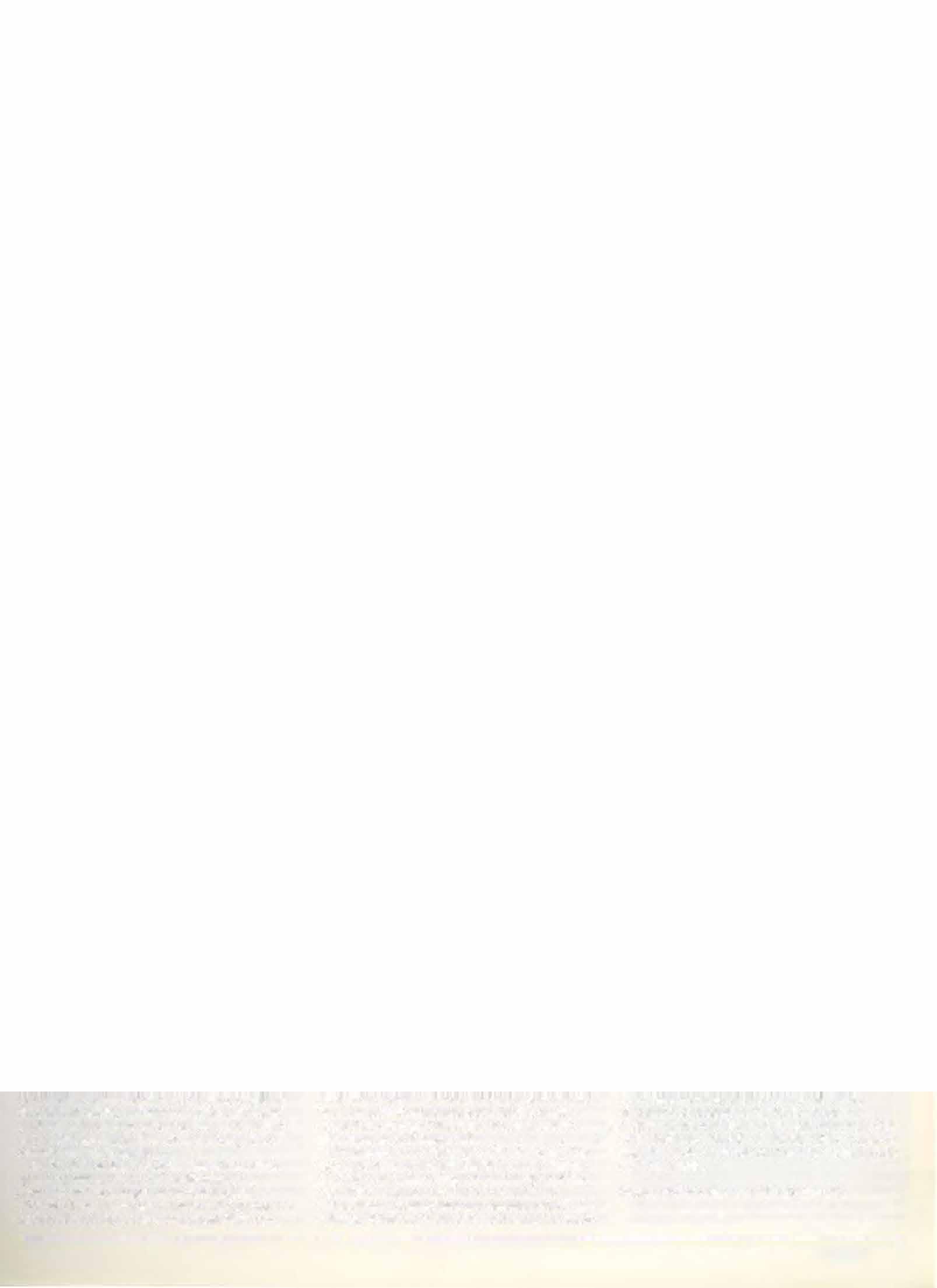
Inc.• 1979-82;worldwide marketing director of Hancock Cardiovascular Products Group, Extracorporeal. Inc., 1982-84; andthen the present post in King of Pru�sia, where heis responsible forregulatory and clinical affairs andquality assurance as well as research and development.
While in academic posts. Dr. Andrews served on admissions, curriculum, andanimal welfare committees; onNational Academy of Sciences/NRC committees involving animal diseases and genetics; and thenlater on a number of councils of the American HeartAssociation and on committees of the Association forAccreditationof Laboratory Animal Care. Author of some 50basic researchpapers, he has continued topublishandpresent at scientific conferences since moving toresearch anddevelopment withJohnson& Johnson units.
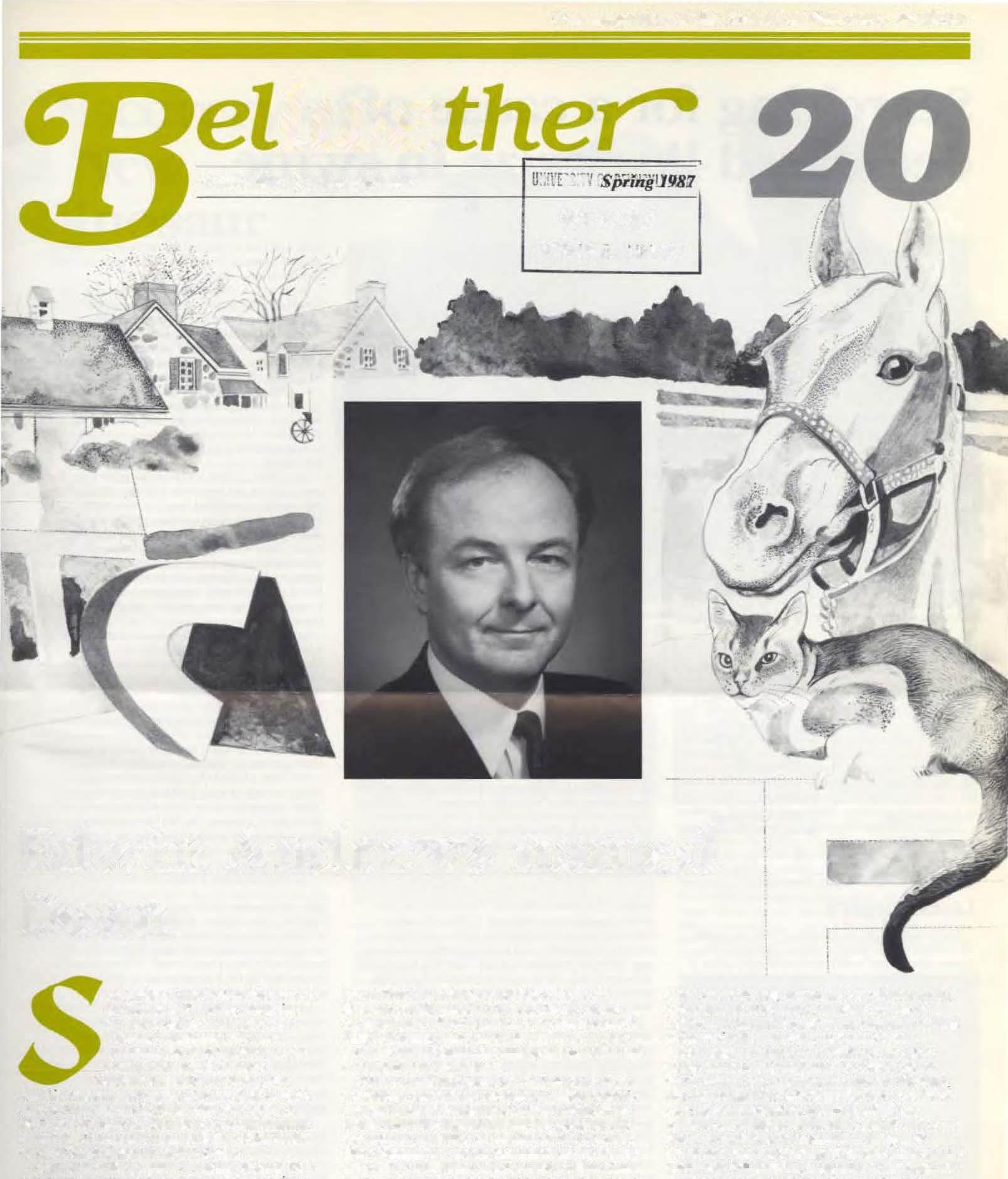
Dr. Andrews is a diplomate of the American College of Laboratory Animal Medicine and a diplomate of the American College of Veterinary Pathologists. Re belongs to a number ofprofessional organizations,amongthem lhe Americanand Pennsylvania Veterinary MedicalAssociations,the Veted-
nary Cancer Society,American Association for the Advancement ofScience, American Society of Laboratory Animal Practitioners, American Society of lndustnal Veterinarians,and many others.
Dr. Andrews named it"'a challenge. an opportunity. and certaioJy an honor"to follow Deans Mark Allam,now emeritus,and Robert Marshak. whobasheaded lbe School for the last 14 of his30 year at Penn. President Hackney called Dr. Andrews an excellent choice for a school with a tradition of excellence inleadership-citingin Dr. Marshak's case the building of the new small animal hospital in Philadelphia.expansion of the large animal hospitalatNew Bolton Center, where Dr. Marshak had established the National Cancer Institute-sponsored Bovine Leukemia Research Center tn 1965 and where the C. Mablon KlineCenter is regarded asthe most advanced equine treatmentcenterin the world.
Reprinted from Almanac, Vol. 33, No. 23)
Searching for a cause of decreased litter size in swine
aisinghogs formarket if\competativebusiness.The farmer looks forlargelitterstooffsetthe costS offeed.labor,housmg,and veterinaryexpens�s.Smalllitters canquickly cat intothetight profitmargin.
"Reduced hilersizeisanimportam causeof loweredreproductiveefficienc) in wine." aid Or. Rtcharcl A. Mcfeely,professor of reproduction at the Universttyof PennsylvaniaSchool ofVeterinary Medicine."Andthere is increasingscientificevidence from EuropeandJapanthatchromosometranslocati<.lnscontribute to reducedlitter st7e in swine."To investigatewhethersuchchromosometranslocauons playarole in reducedlitter size in Pennsylvania swineherds, Or. Mcfeelyhasreceivedagrant fora two-year study fromthe Pennsylvania Department of Agriculture."At this timethere are noreports of chromosome translocations inswme tnthe United Stat�....Mcfeelysaid.''Butstudiestnothercountne-'>suggest thatthismaybe auniven.alproblemin 'wine"
He explujnedthaLswinehave 19pairsofchromosomes. 1ramlocauonoccurs ifaptccebreaksfrom one chromosomeandattachesitself toanother.This can be causedbyan insult tothechromosomessuch
asradiation. viralinfection, or expo:,uretochemicals. Apparently. at can alsohappenspontaneously. When translocationoccurs,the geneticmaterialof thereproductave cellsmaybecome unbalancedand affect theoffspring. Scientists haveiclenufiednine differentchromosomaltranslocationsassociated with embryonic deathandstillbirth. Animalsfrom smallIitle�may carry thetraitandspread it funher ifthey are mated
geny andthat II percent ofembryos andfetuse:. studiedbetween 10 and 88 daysof gestation had translocauons which were lethal Normally, a lttter of swine number<, ctghtto ten. Dr. Mcfeely's study will determaueto what extent chromosometranslocations maybeassociatedwith decreased ferti)jtyinswinein Pennsylvania. Aquestionnaire bas been sent to swine breedersasking about littersi1e. Onceherds with�mall litter size havebeen identified,asecondque!>tionnairewillbe sent askingmoredetailedquestions.rherc willbea kitforobtaintng blood samplesfrom the boarsinthe herd lt is plannedlhatthe herdvetennariandraw andsubmit the sample. The swineproducer willbe compensatedat afixedratefor each sample :.ubmitted.
The blood sample will becultured in the laboratory, and the chromosomes will be analyLed. This will include specializedbanding techmques to adentif}the individual chromosomepairs.The banded chromosomeswillbephotographed andthen karyotyped They will be matched, andchromosome abnormalitiescanbecomeevident.If<10 abnormalh is detected. anattempt willbemade toobtain a bloodsamplefromarepresentattve sampleofthe progeny todetermine whethertheabnormalitiesa:re transmitted.
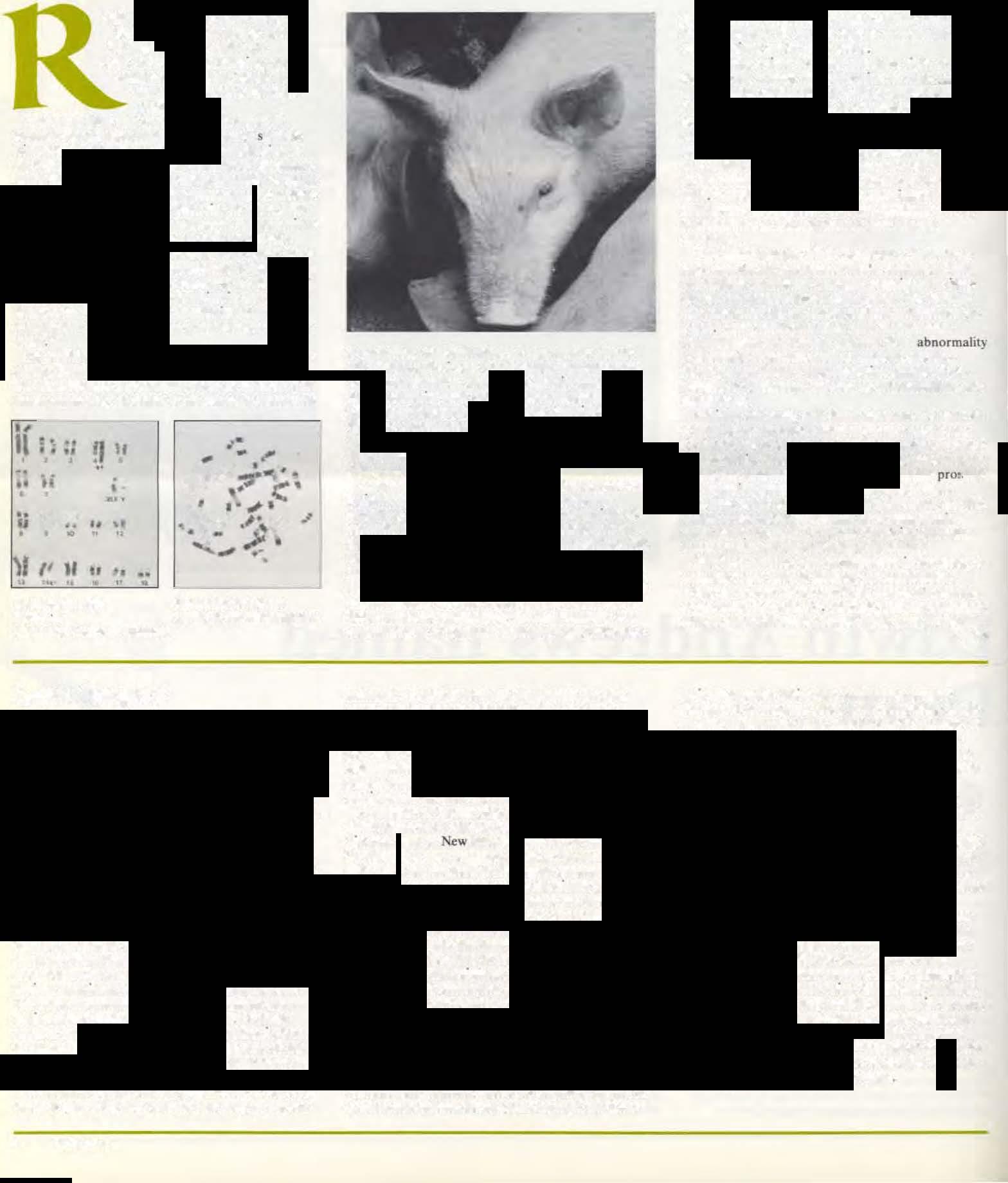
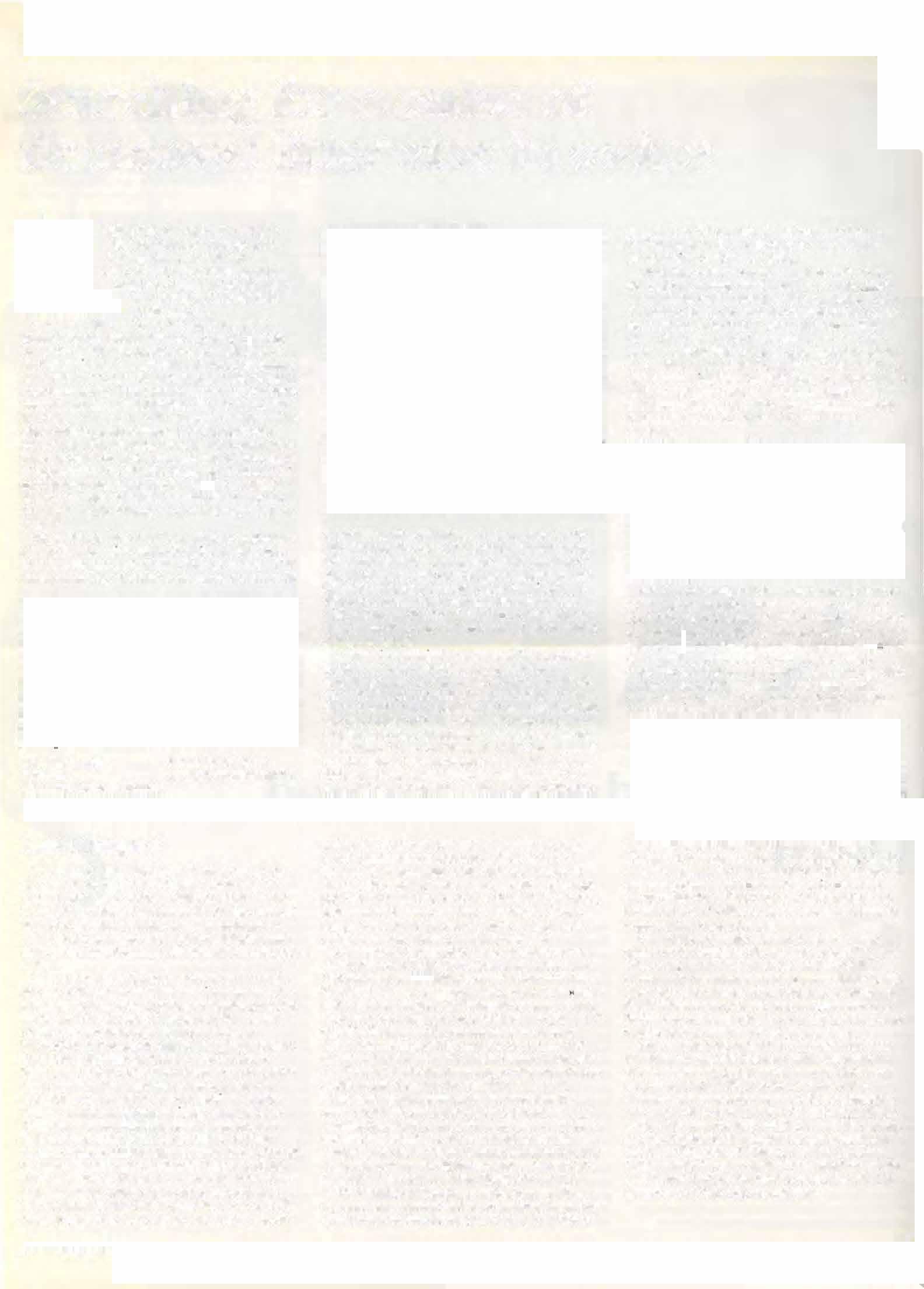
Translocationpig G-banded metaphue karyot}pe spreadofpigchromosomes (photosbyLynneR.Klunder)
LaserSurgery
The�>urgical laser.developedin 1960. hasgraduallyestablishedits placeinhumanmedicine.The Argon laser's most widely publicizedapplication is for repairingretinaldetachmentsin the eye. Usesof the Nd:YAG laser include the transendoscopic removal of laryngealgrowths and the palliativetreatment oftracheal, bronchial, bladder.andesophageal tumorll.
�ow,surgeonsat the Universityof Pennsylvania Schoolof VeterinaryMedicine are mvestigatmgthe feasibilityorlasersurgeryin largeanimals,primarily thehorse."TheSectionofSurgery atNew Bolton Center was fortunate enough to purchasean Nd:YAG laserthroughthe generosity ofbenefactors interested in helpingthehorse,"said Dr. Eric P. Tu.Jieners.assil>lantprofessor ofsurgery."The letters stand for thesolidsubstanceswhichproduce the laser beam. Our machine isa oeody1111um-doped, yttnum alummum garnet, opttcaUy pumped laser. Thebeam istransmitted through a4-meter-long, fiex1ble fiber. about 2 mm indiameter." Alaser beam,a form ofelectromagneticradiation,ISformed bynearlyparallelmonochromaticlightraysofthe samewavelength.Thebeamisveryfocusedand its intensityvaries,depending on the powerutilized. Themachine at New Bolton provides up to 40 to 60 wattSofpower fornon-contact use, suchas vapori-
Astudy tn Scandmaviaonseveralboors,phenotypacally normal andwithgoodsemenquality, turned upsome stanlingresultl> Oneboarstredhtters with tOOpercentembryonicmonahty, andhe showedevidenceofchromosomaltranslocation. His two full brother siredlitterswhichwere 50 percent smalletthan those producedby othersires with the same dams. These twoboarsalso hadchromosomal translocations. Further studiesof two other boars, fatherandson. showedthatthetranslocationwas transmitted to 41 percent ortheson'slive-born pro-
zation.If aprobe isattachedfor contactuse.the power requirement isreduced to 10 to20 watts. Because thewavelengthof the light isinjuriousto theeye.thesurgeonandnurses wearprotectivegoggleswhenthemachineis inuse.The unit isportable. self-contained,and itrequiresastandard220volt power outlet.Ithas itsowninternalcoolingsource andISaboutthesi.z.eof awashingmachine.
Anumberof horseswithupperrespiratorytract ob�tructionshavealreadybeentreatedsuccei>sfully wuh thelaserat ew Bolton Center.TheLasercan be utilizedin opensurgeryas wellastransendo copicaUy. "We usetheflexiblefiberopticendoscope. and thelaser fiber ispassedthroughthebtopsy channel," said Dr.Tulleners. "Theanimaldoes notrequire general anesthesia;itonlyneedstobe sedated and thearea anesthetizedwith topical(local) anesthetic."
Or.TullencrsfeelsthatLasersurgery maybeuseful in treatingsuchdisordersasethmoidhematomas. entrapment oftheep1glotlis bythearyepiglottic folds. arytenoidchondritis,pharyngealpolyps, and gutturalpouch tympanitis. "Amongother soft tissue applications which may lendthemselvestolaser surgery inthehorsearetreatmentofneoplasmssuch assarcoids,posteriordigitalneurectomies,andcervicaladhesionsandendometrialcystsinmares...
Theintense.focusedbeam oflightproducedby thelaser cancauterize, incise, or vaporize tissue. All ofthese procedurescanbedone through thefiber-

lnittally. the study will focuson boars. "A boarin aherd ha� many more offspring than a !>OW,"said Dr. Mcfeely. Jfchromosometranslocationsorother abnormalitiesthat mightcause reducedlittersizeare found.aneconomicalmethod for screeningpropective brcedtng animalswillbe developed."Such screeningcouldhaveaprofoundeffectupon the efficiencyofreproduction witbm the Pennsylvanta swine herd."he said. "It wouldresuh toeconomic improvement for theindividualbreeders... Mcfeely stressed thatparticipation an the study is volunt<lr)' and thatall findings artconfidential. ''Onlytheowner ofthe herd willreceivetheresults ofthetests."hesaid. Dr McFeely andhisassociates plan to havethis studycompletedbyJune, 1988.
-H.JP:opttcendoscope,wh1chbas atelevision camera attached. fbewrgeonneedsto hecompletely familiarwith endoscopic views,and be needsdexterityto accuratelymanipulatethelaserfiber 10 the small spaces inside theanimal'sbody. Alaser scalpel can be attached tothe ftber to inciseor remove tissue in aCOn'vtntlonal open fasbJon.
Lasersurgerygreatlyreducesthelimeahorse spendsin thehospital.Thedangersofinfectionand othercomplicationsare reduced,andtheanimal oftencan be returnedtotrainingmuchmore rapidl� than after opensurgery. Furthermore. generalanesthesiais often not required. andtheprocedure can be doneonastandinghorse. lnmany instances laser surgerycan bedoneon an outpatientbasis.
Prior todecidingto purchase the Nd:YAG laser, Or.TuUenersand Or. Benson Martin tookseveral courses, including extensive lectures and laboratories. to become certified in theuseof the laser. Recently, a lectureseries andwet lab for physicians was held at New Bolton, USJngthe unit.Inaddition to Dr. Tullcners, Or. Ben Martin, lecturer 10surgery, and Or. Charles Raker. Lawrence Baker Sheppard Professor EmeritusofSurgery.are aJso pursuing research with thisnew device.The School isthefirst veterinaryschoolinthecountry toacquirethisparticular type of Nd:YAG contact laser
Discovery of aNew Dinosaur
inosaurs bave been in the news a lot recently and Dr. Peter Dodson, associate professor of anatomy at theSchool. had something to do w&th that. In December, Dodson introduced Avacerarops lammersi to the public at the Academy ofNaturalSciences of Philadelphia. This event marked a five-year quest to tdentifyfoss1l bones found in Montana 10 1981.
"Avaceratops lammersi lived about 75 million years ago. It was a small. plant-eating dinosaur." he explamed. "Thefirst new kind of horned dinosaur found in "'lorth Amenca in 35 yearl>, this animal was about the size of a boar and seven feet in length. It is nJUVenile and we e&timate the adult size at about 12 feet.wbtchb. considerably smaller than that of other horned dinosaurs of thatperiod."
Little d1d Dodson know that a tnp toSouth Dakota to examme some fossil bones would lead to the discovery of a new species."The first bone<> were found by Eddy Cole, a fo!>Sil coUector from Wall. South Dalota," saidDodson."Cole had travelled to Montana. which is known for dinosaur fossil deposits. to look for bones." Cole began his search on the Careless Creek Ranch. a 46.000 acre ranch located nearShawmut.Montana. Here, in an arid secuon,
he came across dinosaur bones "Millions of vears ago Montana was a wet land, with swamps a�d rivers and much vegetation. The site of the fossil find is an ancient riverbed. and it appears that the animals penshed during a flood. There are many bones fromjuvenile dinosaurs, crocodiles, turtles, and some mammals ..
Good fortune played a large part inDodson' involvement in the discovery of a new dinosaur."Cole was somewhat unusual in that he carefully mapped the excavation site and the location of each bone. He also thought that a scientist ought to look at his find before he dtSpersed the bones." Cole called a friend 10 Los Angeles who contacted a paleontologist at Harvard. Dodson came into the picture when his colleague asked him to speak to Cole. "It was a bit of a trickySituation;' said Dodson. "Paleontologist!> on thewhole are not too keen on private foss1J collectors. Also, the bones could havebeen something quite ordinary."
Dodson visited Cole and examined the700 fossil bones.The collection was a mixture of remams from anumber of species, among them bones from a rare horned dinosaur. Docl�>nngotexcited when he spotted a frill, a bony structure extending from the back of the skull of ceratopslds and characteristic of these animals."I asked whether there were more skull bones at the site.·· he said. ··cole said ·yes'."
Dodson was determined to obtain the collection of fo�sils for theAcademy of NaturalSciences of Philadelphia.Cole agreed to selllhem for$5,000, even though he had spent aboutS8,000 on the excavation. Cole also agreed to take·Dodson to the site in 1982. TheAcademy had no funds available, and Dodson mounted a grass-roots campaign to bring the fossils to Philadelphia. His wtfe and friends baked dinosaur cookies and created dinosaur buttons. These were sold at paleontology fairs. and Dodson took his message to schools and paleontology meetings. He generatedquite a bit of enthusiasm and in ten months the funds were raised.
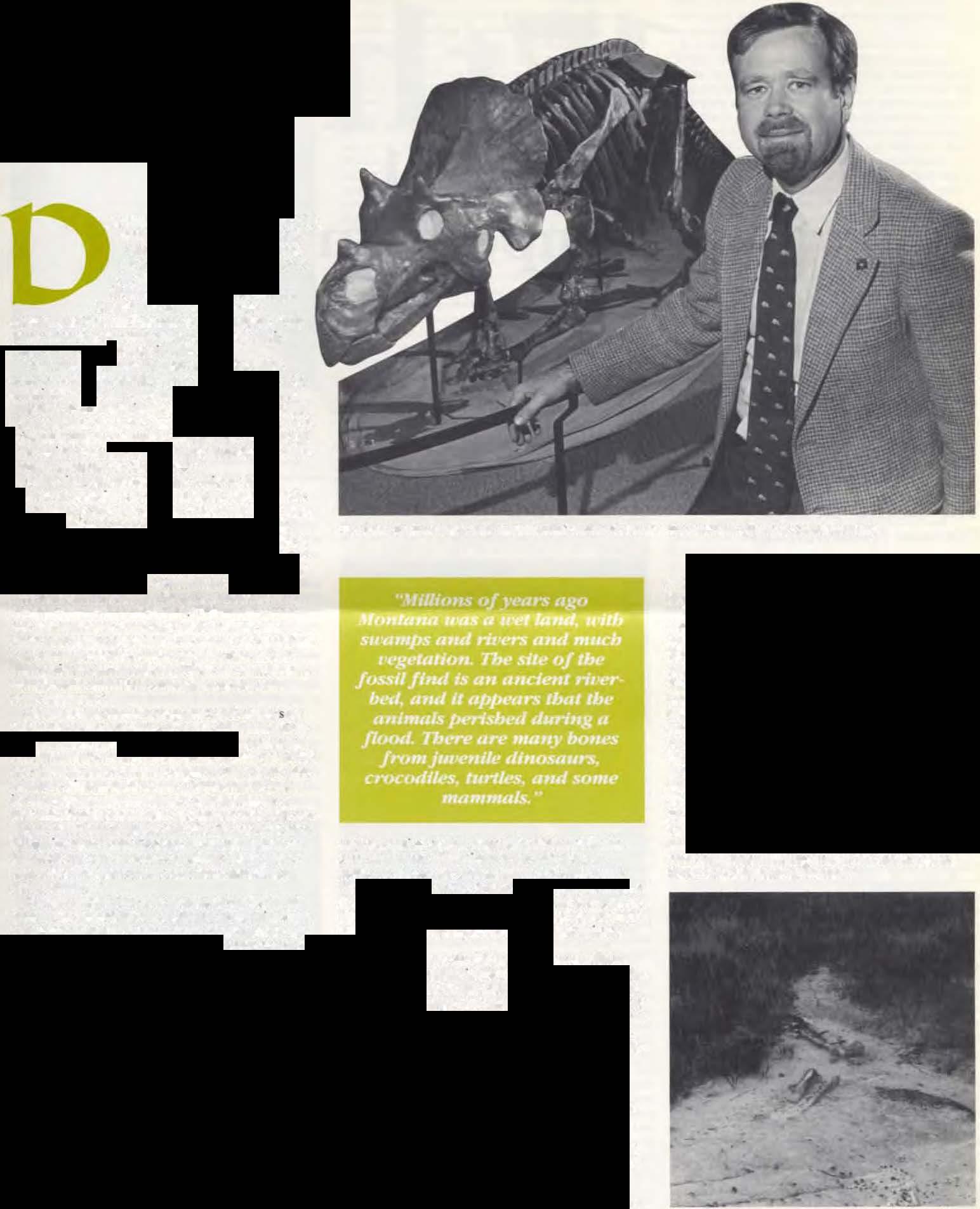
TheNationalGeographicSoc1ety provided a gram which enabled Dodson to travel to the site in 1982. As Cole bad proffilSed. there were plenty more bones


and in a penod of four days 100 additional fossils were excavated. "TheSite is in an arid area. no water. no shade. the nearest house is 4 miles away. We camped and had to bring everything with us. But it was worth it.. Dodson returned to the site again m 1984 under the auspices oflhe Academy and in 1985 and 1986 with fundingfrom theNationalSc1ence Foundation.
The fossils from the 1981 and 1982 excavations came to Philadelphia m 1983 and were srudied at the Academy. At ftrst it was thought that they belonged to a Brachyceratops. But soon it became evident that they belonged to a different species. "The animal was 10 percent larger. and there was a significant difference in the frill bones," Dr. Dodson said. ·•our skeleton's frill was solid, whereas the frill of the Brachycermops has openings."
To make sure that he indeed had found a new dinosaur. Dr. Dodson traveUed to other institutions to examine their collections of ceratopsid fossils. Funding for this was provided by the University Research Fund. It became clear that the skeleton at the Academy was different. "We had a new kind of dinosaur," he said... lt was an 1mportant scientific discovery."
Dodson named his ammal Avaceratops Jammersi afterAva Cole, Eddy Cole's wife, and the Lammers family, owners of the Careless Creek Ranch and very
cooperative to the researcher.. Ceratop:. means horned face.
Peter Dodson teaches:matomv.at theSchool. He also has an appointment in the department of geology and i!> a research associate at the Academy of NaturalSciences. Philadelphia. He served as chief scientific adviser to the Academy's new permanent dinosaur display...It isquite fittmg that the fossil is here in Philadelphia," he said."Philadelphia was the birthplace ofAmerican paleontology in the mid-19th century. The first reasonably complete dinosaur skeleton in the world was discovered in Haddonfield, New Jersey, in 1858."
Dod on has been fascinated by dinosaur!> since hi!. youth. "l always wanted to be a paleontologtst. and, of course, finding a new species isjust like a dream." He studied geology and received his Ph.D. from Yale. •'There are fewjobs for paleontologists. so you must do something to earn a living. I chose anatomy and l have been teaching here at theSchool since 1974-and delighted to be here....
Or. P�ttrDodson witharuiJyuc:onstructedmodelofAvauratopslamm�rsi.(photobyDavidB�nnelt)Annual Symposium
ThecanineGenetic DiseaseInfonnation System
The first speaker, Dr. Donald F. Patterson, Charlotte Newton Sheppard Professor of Medicine. and Chief, Section of Medical Genetics, discussed the Canine Genetic Disease Lnformation System (CGDIS). He pointed out that genetic defects now are perceived as an important medical problem by the general public. "The advances in vaccine development. nutrition, and new methods of dealing with parasitism over the last three decades have largely eliminated severe illness due to infectious and debilitating diseases in man and animals." he said. "As a result, there has been a gradual shift in the nature of health problems, away from those that are due to causes exlTinsic to man and animal and toward those that are to a large extent genetic ln origin."
To date. more than 200 genetic diseases of dogs have been described in the literature. Diseases that have a major genetic component include a large variety of congenital malformations (cleft palate, hernias, heart defects), abnormalities in growth and development (hipdysplasia.cryptorchidism), endocrine diseases (diabetes, hypothyroidism). and progressive degenerative disorders (progressive retinal atrophy, cerebellar abiotrophy). A rapidly expanding number of metabolic diseases are being recognized (mucopolysaccharidosis. copper storage). Inherited deficiencies in the immune system are now known to cause some dogs to have increased susceptibility ro infectious diseases. A genetic component has been recognized in certain forms of cancer (osteosarcoma, mastocytoma). and in a number of degenerative disorders associated with aging (intervertebral disc disease, chronic valvular heart disease).
The variety of dog breeds is tremendous; no other mammalian species shows such diversity. Differences between breeds are genetic, due to selection for various features and qualities. Each breed of dogs represents a genetic isolate. a group of individuals sharing a specific gene pool; and each breed tends to have its own genetic diseases. ln selecting for specific breed characteristics, man unwittingly selected also for genes which interfere with proper development in each breed.
Currently, new genetic diseases are recognized and reported every month, and the rate of discovery is accelerating, due to an increasing sophistication of
diagnostic methods in veterinary medicine. Many more genetic diseases are known or suspected by breeders and veterinarians but are not sufficiently well-studied to be reponed in publications. As information continues to accumulate, dog breeders, breed organizations. and veterinarians will bave an increasing need for a comprehensive source of information regarding the genetic defects that have been proven to occur in each breed. including their diagnostic features and their modes orinheritance. Also neededis information regarding defects that are strongly suspected but not yet proven to have a genetic basis. Evidence of this kind can serve as a valuable "early warning system" which could be used to alert breeders to an emerging genetic problem.
In the past, compilations of genetic disorders have been made, but they are too Limited in scope and cannot be kept current enough to satisfy the present needs of dog breeders and veterinarians. It has become apparent that the expanding body of available information cannot be efficiently organized. kept up-to-date month by momh. and made accessible by any system now available. A new method, using modem computer technology, is needed. Computerized access allows the user to answer questions of greater variety and complexity witb increased speed and permits the inclusion of additional information as new knowledge evolves. A system of this type will have a number of important benefits to the purebred dog world:
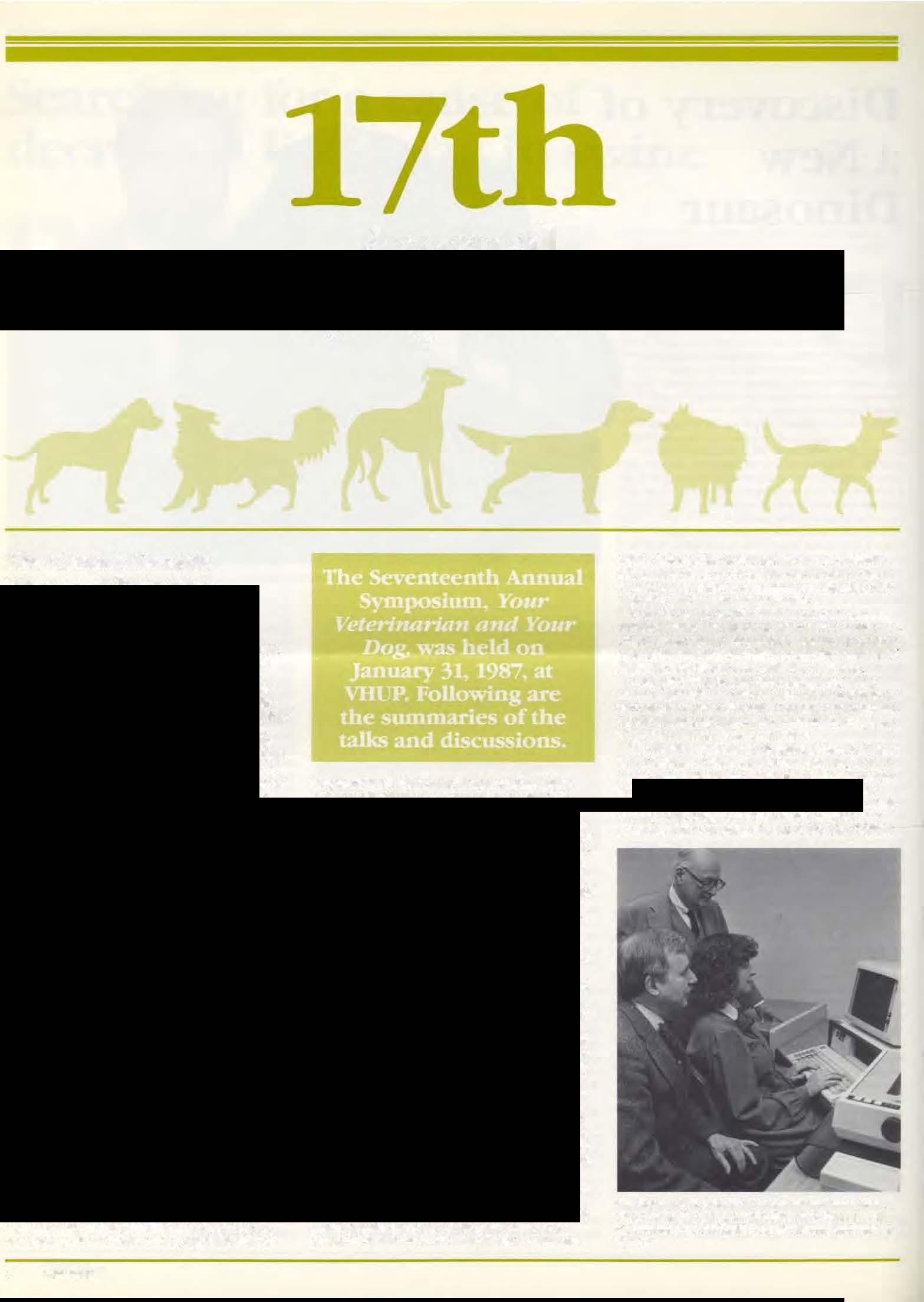
I. It will provide a compendium of current information that can be used by owners. breeders, and national breed clubs to keep track of known and suspected genetic disorders within each breed on a month-to-month basis. lf national breed clubs con-
tribute information to the system as well as obtain information from it, the system can serve as a rocus around which genetic committees can organiLc their activities and become more effective.
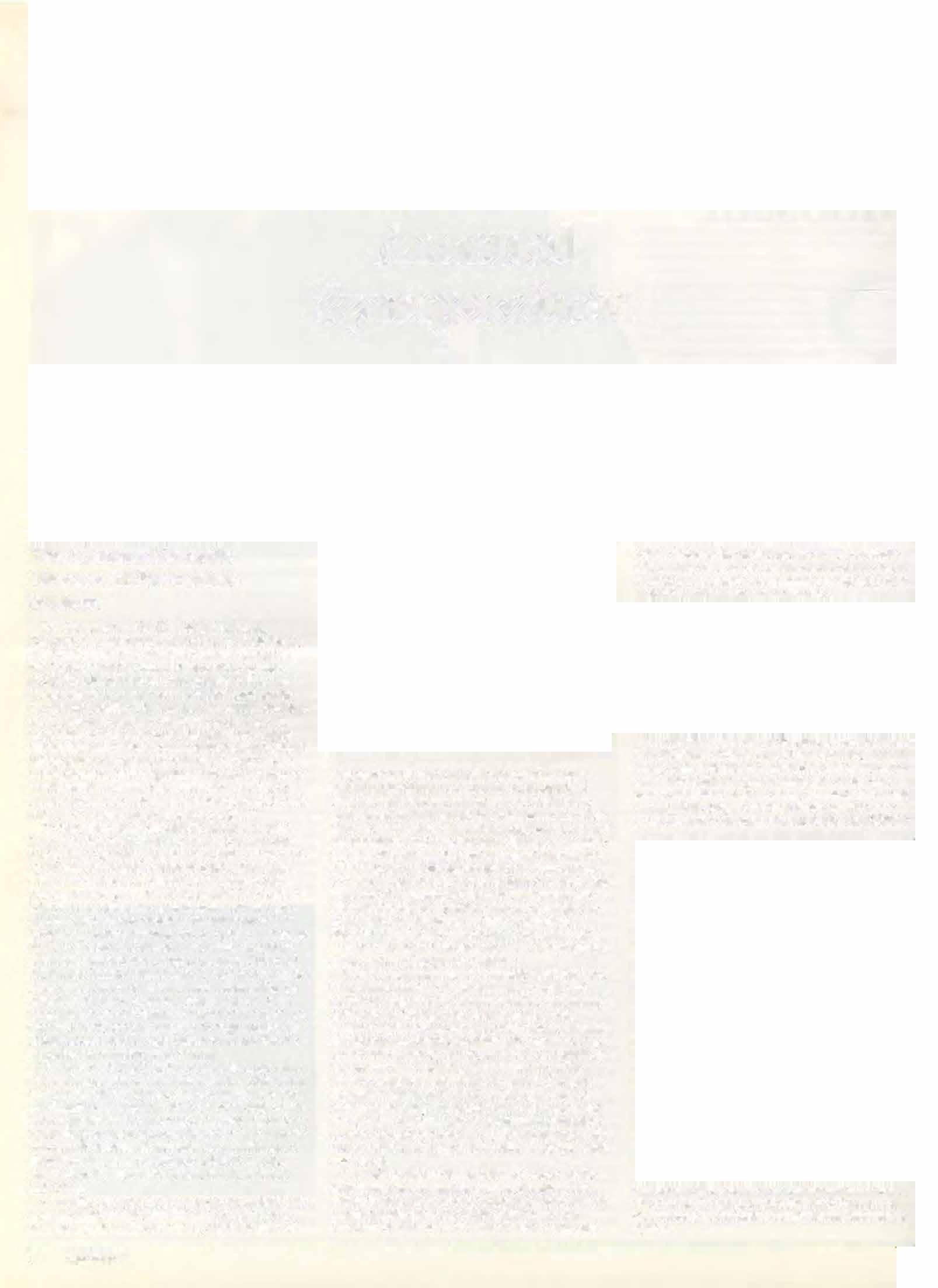
2. It will create. for the first time, a truly current and comprehensive source of information to help veterinarians recognize the genetic diseases that occur in each of the breeds. This will improve the accuracy of diagnosjs and lead to more effective treatmenl.
3. By providing current information regarding modes of inheritance and tests for the recognition of carriers, the system will assist breeders and veterinarians in developing programs to reduce the frequency of genetic diseases in purebred dogs.
The Section of Medical Genetics, School of Veterinary Medicine, University of Pennsylvania. is developing a comprehensive system that will make up-todate information on genetic disorders of the dog readily available lo breed clubs. breeders. and veterinarians. Tbjs project bas been made possible by a grant from the American Kennel Club. The CGDIS
Syndrome of Short-Limbed Dwarfism with OcuJar Defecls in Samoyeds
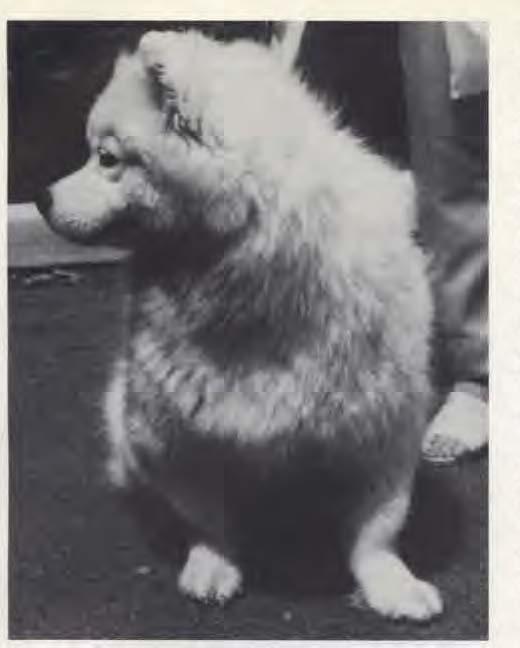
Thisis a recessh-ely-inheTited defect in tbe de�elopment of the bones. Alfected dogs have short legs, outwardly deviated front paws, and defects of the retina and lens or the eye.(Photo reprinted fromJAVMA, Vol. 1.8.3. No. 9, November I,1983)
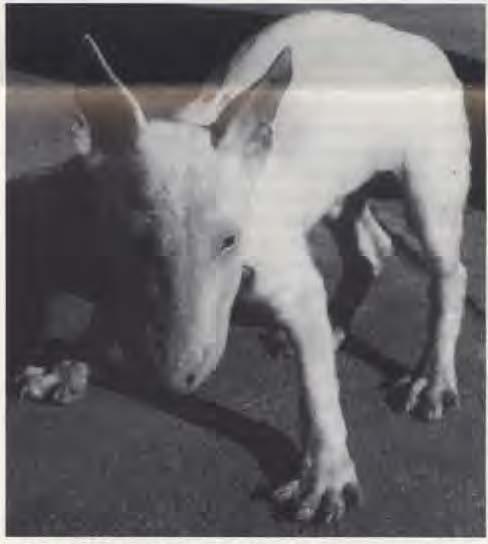
will be computer-based, using microcomputer capability. The software and information base being developed by the Section of Medical Genetics can be utilized directly by veterinarians, breed organizations, and others with interest in genetic defects of the dog. To make it available to the largest number of users, the program is written for the IBM-PC and compatjble machines. Users will be able to obtain updated versions of the information base at intervals. The system will be continually updated on a monthly basis. Information will be gathered from the published literature, research workers, practicing veterinarians, veterinary institu1ions, breed clubs and breeders, as well as our own genetics clinic.
A monthly survey of scientificjournals and breed club publications in this country and abroad will be osed to keep the data base current. We also propose to establish a network of veterinary institutions and breed club genetics committees which will provide an additional source of evidence regarding previously undocumented genetic defects. The institutions will include the veterinary schools in this country, and other large teaching hospitals. ln some cases, practicingveterinarians will provide information. The genetics committees of the national breed clubs will be encourdgt:d to submit information.
The information will be gathered, extracted, and entered into the computerized system by a coordinator, after review by members of the Section of Veterinary Medical Genetics. The professional personnel involved in the project are: Dr. Donald F. Patterson, project director: Dr. Gustavo A. Aguirre, professor of ophthalmology in medical genetics; Dr. J. C. Fyfe. resident in genetics; Dr_ Urs Giger, assistant professor of medicine in medical genetics; Patricia L. Green, project coordinator and bibliographer; Dr. Mark E. Haskjns, associate professor of pathology and medical genetics; Dr. Peter F. Jezyk, adjunct associate professor of medkine in medical genetics; Dr. Vicki Meyers-WaUen, assistant professor of
reproduction in medical genetics; Dr. Stephen P. Scb.iffer, assistant professor of laboratory animal medicine and medical genetic.'<.
The system will contain tne following information: name of each genetic disorder and common synonyms; breeds affected; status as to whether established or suspected; system or systems of the body involved; diagnostic features, including age of onset, physical signs. laboratory test fLndings, and pathology; mode of inheritance; tests for the recognition of carriers of recessively inherited diseases; recommendations for control of the disorder (genetic counseling); references to sources of available information; names and addresses of individuals and laboratories providing special expertise or tests for specific disorders.
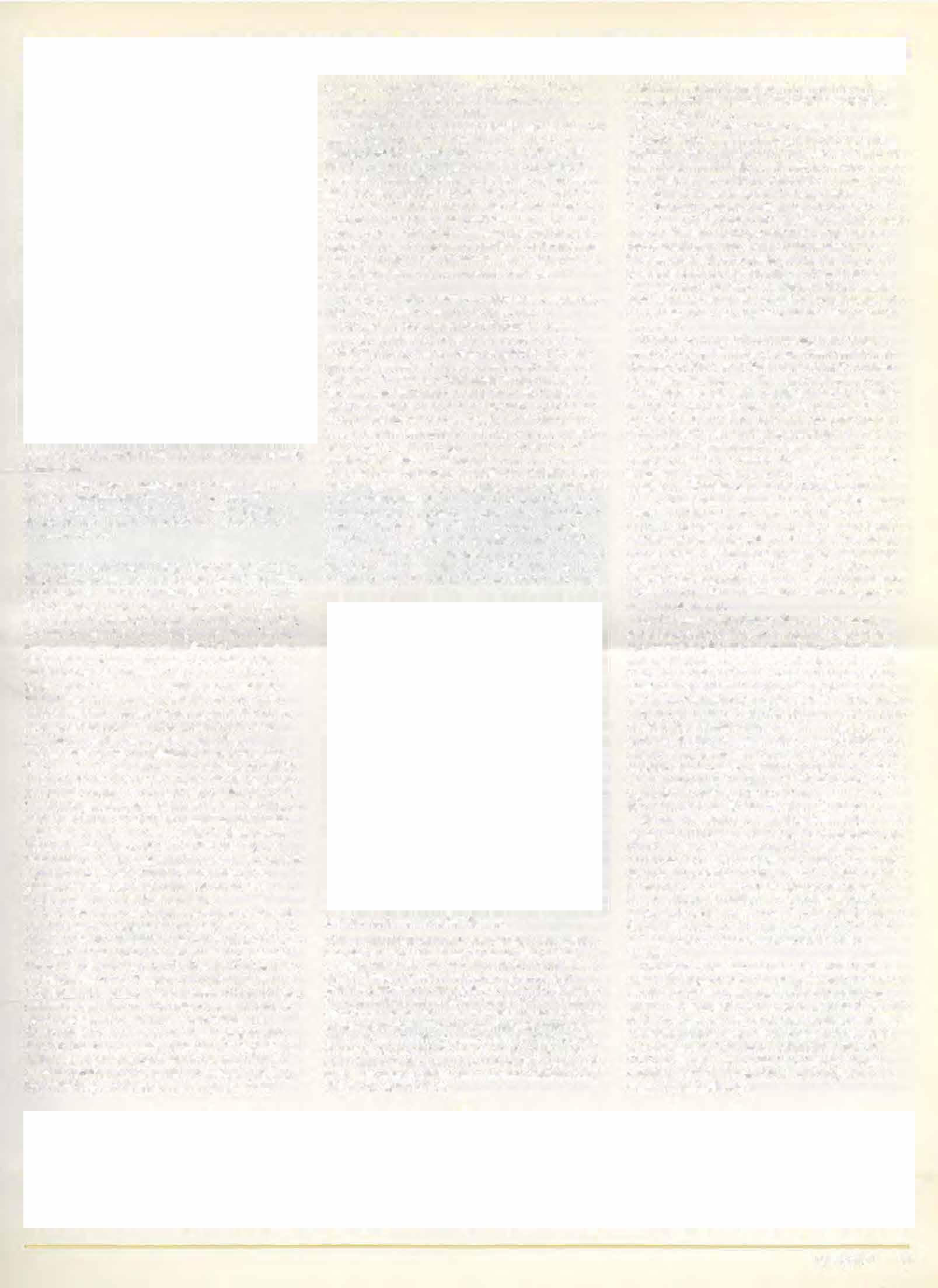
The system will contain no information about rhe identity ofspecific animals or their owners.
The computer program for CGDlS has been under development for more than a year and the initial version is now nearing completion. The program is designed to be user-friendly and will allow display and printout of information in a variery of formats. Breeders and veterinarians will be able to query the system and obtain information pertaining to currently known or suspected genetic defects in a breed. Diagnostic criteria will be provided as weU as age of onset. physical signs, laboratory tests, and mode of inheritance. Veterinarians can use it as a diagnostic aid by listing a specific set of clillical signs and symptoms, and by requesting a list of genetic disorders responsible for such signs. Laboratories performing special tests for specific genetic disorders or carrier detection will be listed. Also principles of genetic counseling for each specific disorder will be provided. In addition, the system can furnish a list of breeds in which a speciJic genetic disorder occurs. lt can also list genetic disorders witb a particular diag-
nostic feature, and it can provide literature references and other sources of information regarding any genetic disorder
lt is anticipated that the first version of the CGDJS will be available during 1988 for use and testing by other institutions and breed organizations. Once the system is fully developed. it can serve as an immediate source of information by answering direct inquiries from breeders, breed clubs, and veterinarians. Further, periodic written reports to the American Kennel Club. breed organizations. and the veterinary profession can be provided. It is anticipated that the software and current information base will be made available as a package. The data base will be maintained and updated by the University of Pennsylvania, but other institutions will be encouraged to obtain the software and information base for use locaUy. That way regional information centers can evolve.

The long-term goal is to encourage the development of a comprehensive program that can be used throughout the United States and abroad to recognize and control genetic disorders in purebred dogs. By cataloging and making available tbe burgeoning knowledge on the known and suspected genetic disorders in each breed and by stimulating the cooperation of veterinarians and dog breeders in the collection of this information, tbe stage will be set for the next step, wbich is to establish comprehensive cenification for genetic diseases. A program of comprehensive certification will use the CGDIS as the source of information needed to specify which examinations and laboratory tests are necessary to recognize all of the known and suspected genetic disorders witbin each breed. Breeding animals could be taken to a veterinary institution and tested for the known genetic defects of that breed. Breeders would not bave to take their animals to a number of speciatist.s in different locations. But such certification program is still in the future.
Lethal Acrodermatitis inBuJJ Terriers
Thisis a recessively-inherited defectwhichis fllSt notedas retaTded growth and difficulty in eating. Sldnlesions develop around the eyes, ears and mouth, and on the feet, and the footpads �ome bard.The toes are splayed. Affected pups are verysusceptibleto infection and usually have repeated infections. We believe this to be an inherited defect in zinc metabolism,sincethe clinical picture and the pathology are identical to zincdeficiency.However, the pupswere all fed a diet adequate inzinccontent,and zinc treatments do not cure the disease.There is apparently some "block"in the metabolism orzinc which prevents the body from using it. (Photo reprinted from JAVMA, Vol. 188, No.8, April IS,1986)
Dr. Patterson then brieny discussed subaortic stenosis, a genetic disorder emerging in the golden retriever. This disease also occurs in the Newfoundland and has been studied extensively in this breed. The disease affects the heart and can cause sudden death due to arrhythmia. It is inherited, apparently through a dominant gene with modifiers. This causes varying expression of the disorder; some animals are hardly affected while others may show symptoms early in life. He pointed out that, once CGDlS is in place, emerging problems in a breed, such as SAS in goldens, can be made known more quickly to veterinarians and breeders. This wouJd lead to earlier testing of future breeding stock. and the prevention of the spread of a newly identified genetic disorder. He then touched on inbreeding, frequently blamed by tbe popular press for problems in purebred dogs. Dr. Patterson pointed out that inbreeding, the mating of closely related animals, in itseJf, does not produce defects. Rather, it brings out the defective genes carried by the animals. "Inbreeding is necessary to flx certain genetic traits, but when inbreeding is practiced iL is important to realize that hidden genes for genetic defects will become apparent. Of inbred animals, only the best should be retained for breeding."
During the question and answer period be also stated the importance of keeping accurate records to monitor problems and progress in a breeding program. "When trouble occurs, you can refer back," be said. ''You may be able to detect a pattern and then something can be done about it before it becomes too widespread." He expressed the hope that the CGDIS will stimulate a dialogue among breeders and that it wiU facilitate the control of genetic dis· eases in purebred dogs.
CanineReproductive Problems
Dr. Vicki Meyers-Wallen discussed canine reproductive problems in the bitch and dog and how they can be recognized, treated, and prevented
On the average, bitches cycle everyseven months and the reproductivecycle can be divided into anestrus; proestrus: estrus; pregnancy; preimplantation period, period ofthe embryo, period ofthe fetus; whelping; and lactation. Problems can occurat all stages and theveterinarian must know at what stage the problem isoccurringin order to approach it in a rational manner. An important step in preventing and recognizing problems is good record keeping.
Anestrus is a period ofreproductive quiescence. Toward the end ofthis period, hormonal changes occur internally whichprepare the bitch to come into season. Bitches that fail to cycle may have problems unrelated to the reproductive system such as hypothyroidism, Cushing's disease, liver or kidney ailments, or other major illnesses which prevent the initiation ofa normal cycle.
Proestrus marks the period when external signs such as vaginal swelling and bleeding occur. However, some bitches may cycle but do not present any external signs. The problem can be circumvented by good records and then taking weekly vaginal smears during the period that proestrus is most likely to occur.
Estrus is a very important stage since ovulation occurs during this period. The most frequent problem duringthis period is that sperm are not present in the oviduct during the periovulatory period. so fertilization does not occur. Good breeding management is essential to correct this. Failure ofovulation is less common. It can bedocumented by serum progesterone determinations. Abnormal anatomy which prevents the union ofsperm and eggscan also occur. This includesthe obvious vaginal stricture which is painful and prevents a"tie,"and the less obvious abnormalities where part ofthe uterus or oviducts may be missing, obstructed, or infected.thus preventing the sperm from reaching the eggs in the oviduct, where fertilization normally occurs. Vaginal strictures can be removed surgically. Usually such bitches whelp normally, though one should be prepared for a C-section.
To pinpoint the best days to breed a bitch, vaginal smears should be done, beginning in proestrusand alJ the way to diestrus. The vaginal cytology changes and, when a bitch is ready to breed, cells will be90 percent or morecornified. Breeding should bedone everyotherday untildiestrus becomes evident in the smear. Dr. Meyers-Wallenexplained that the firstday-of-diestrus vaginal smear provides avaluable clue as to when ovulation occurred. Bitches ovulate six days prior to diestrus, and there is a"golden period" when the conception rate is high. It is from 10 to 4days prior to the onset ofdiestrus. Studies have shown that bitches bred during this period had a good conception rate and good litter sizes. She pointed out that ifabitch bred in this period misses, then management is unlikely to be the problem and one must look for other causes. Knowing the first day ofdiestrus also makes the calculation of the whelping date easier. Generally bitches whelp 57 days from that date.
Theperiod ofpregnancy is divided into three phases: preimplantation period, period of the embryo, and period ofthe fetus. During the first phase, which lasts l9 days, the fertilized eggs Ooat in the uterine horns and then attach to the walls. In the next period (19-35 days), organsystems are formed
and the placenta is in place. If the bitch suffersan insult, such as infections. exposure to toxin, etc., fetal deathscan occur and theembryos are resorbed. During the final period, 35 days to birth, thefetus continues to grow. Lfa fetal death occurs, the fetus will be expelled. Hormonal abnormalities ofthe bitch and infections ofthe bitch orfetus are the best known causes of fetal death duringthis period. Abortiondue to Brucella canis occurs most often during this time. Routine prebreeding tests of the bitch and stud are recommended to prevent the spread of BruceJ/a canis.
Dr. Meyers-Wallen also pointed out the impor� tance ofearly pregnancy diagnosis. lt can bediagnosed by palpation at 28 days and by ultrasonography at 21 days from the first breeding. Routine early pregnancyconfirmation is recommended to differentiate between failure offertilization and embryonic death, since the causes ofthese two problems may be quite different.
Sbe emphasized the importance ofrecords and recommended that a chart be kept on each breeding bitch. On it the breeder should note the results and date ofbrucella tests,the date of the beginning of proestrus, estrus and diestrus, breedingdates, palpation date, whelping date, number ofpuppies, Living and dead, and problems encountered Such records can be a valuable reference in case of problems at a laterdate, and it can help the veterinarian to determine a treatment to correct a problem.

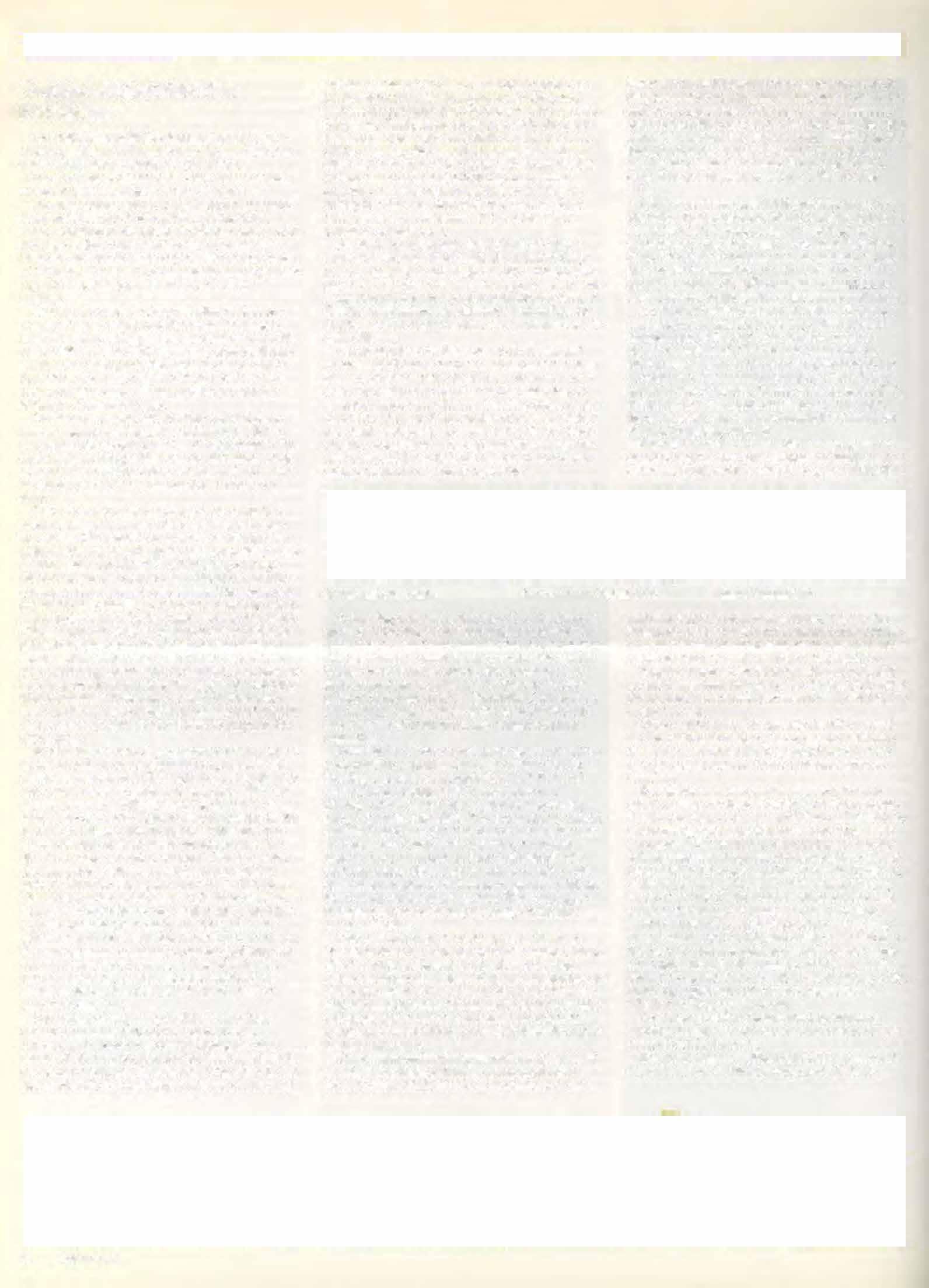
futurefor artificial insemination or frozensemen, it may begood to occasionallycollecthim so that be is used to the procedure. Thismay be best attempted on later breedings, not on his ftrst breeding. Breeders should be sure that the dog is not traumatized bythe experience, since be maynot forgettheexperience and become difficult to breed. Ifthe dogis timid. more timeshould be allowed or adifferent bitch used.
Good records are essential if problems are to be identified at an earlystage. Every breeding should be recorded: bitch. her age. dates ofbreedings and whether they were inside ties or artificial inseminations. The date of whelping and the numberof puppies should be recorded, as well as the bitch which did not conceive. Brucella canis testsshould be recorded as well as the results of the semen evaluation.
Dr. Meyers-Wallen pointed out that a 75 percent whelping rate is accepted as being within normal expectations. rfthe dog's rate is helow that, be should be evaluated. Ifhis rate is greater but he misses two or three bitches in a IOW, he should also be evaluated. The numberofpups per litter is also useful in that a decrease in littersize can be the first indication that the sperm numbers are decreased. Early detection may prevent irreparable damage to the stud's breedingcapacity.
She explained that it takes 54 days for sperm to develop. Ifgerm cells have suffered an insult. such as infection, it will not be evident forquite awhile. She
Proestrus Vaginal Cells Estrus Vaginal Cell

A stud dog is an important part ofa breeding program, and Dr. Meyers-Wallen emphasized that the malechosen should havesuperiorbreed characteristics and should be anatomically normal. He should be free from inherited defects. Sbe recommended that a reproductiveevaluation be done soon after puberty, at the age of 10 to 12 months. Such evaluation includes: examination ofthe reproductive system, behavioral evaluation, and complete semen evaluation.
Examination ofthe reproductive system should be performed by a veterinarian to be certain that the breeding apparatus is normal. For che behavioral evaluation the young male is introduced to a friendly, estrus bitch in the usual breedingsetting every 1-2 weeks if possible. It is not necessary that be actually breed:just give him time to figure out what he is there for. Observe his behavior� he should become more interested and less intimidated with each encounter. He should beeasy to handle at all times and not allowed to become aggressive with the bitch or the people handling him. When he begins mounting behavior, he may be readyfor his first semen collection.
This collection and the subsequent evaluation should be done by aveterinarian. The semen evaluation includes: measurement ofvolume, motility, sperm count per ejaculate, and sperm morphology to determine whetherthe sperm is normal. It is important to rememberthat the sex drive usually precedes sperm production. lfthe flrst collection is not so good, one should wait two months before the semen is evaluated again.
Once semenevaluation is normal, the dogshould be allowed to breed naturally to anexperienced friendly estrus bitch. Ifhe is to be collected in the
said thatstud dog owners should recommend that bitches be checked earlyfor pregnancy. lfa problem is suspected with thedog, then action can be taken earlier than if one waits until the whelping date.
Vaginalsmears ofthe bitch provide a good guide forthe proper breedingdate, and the stud dog owner should have such smears performed while the bitch is in hisfhercare.
Dogs which are used frequently should be tested for Brucella canis twicea year. A semen evaluation should be done annually. Dogs that have not been used for awhile should also be evaluated prior to breeding.
During the question and answer period it was asked whether the thyroid status is related to reproductive problems. Dr. Meyers-Wallen indicated that. theoretically, hypothyroidism could be responsible for reproductive problems. She cautioned that thyroid replacement drugs should not be given without priortesting. The most accurate test is the TSH test. which measures the function of the gland. Resting levels ofT3 and T4 often do not given an accurate result as thevalues are subject to interpretation.
The question ofvaccinating a bitch during pregnancy was raised. Dr. Meyers-Wallen indicated that it is best to vaccinate prior to breeding to get maximum protection for the puppies. False pregnancies shoul� be regarded as normal. as the bitch has a high level of progesterone after estrus, regardless of whether she is pregnant or not.
Dr. Meyers-Wallen stressed the importance of workingclosely with lhe veterinarian and the importance ofdetailed records.
Dr. Vicki Meyers-Wallen is assistant professor of reproduction in medical genetics at the School.
RabiesUpdate
Dr. LawrenceT. Glickman. associate professorof epidemiology and Chief. Section of Epidemiology, discussed therecent rapid increasein tbe number of rabies cases in Pennsylvania.
Rabies is a fatal viraldisease affecting the central nervous system. It is transmitted through the bite from arabid animal. The diseasecan affect all warmblooded animals, including man.Thenumber of casesseen in wildlife, dogs, catS, and livestock io Virginia, Maryland, and Pennsylvanja has increased dramaticallyduring the last seven years. Pennsylvania now has a mandatory rabies vaccination law fordog and cats. Such vaccination decreases the chances ofhuman eJq>osure to the disease. as vaccinated animals act as a buffer between humans and wildlife.
Many ofthe new vaccines for cats anddogs are effective forthreeyears; then a booster is needed. An exception is the young animal vaccinated under one year ofage that requires a booster at age one and then three years later. At this point there is no vaccine for wildlife, though several researchers are developing such a producL
FeedingProgramsfor ProblemDogs
Dr. Susan Donoghue, assistant professor of nutrition, discussed the feeding ofproblem dogs. She pointed out that for most dogs the nutrient requirements are quite broad and that dog� tolerate a range offoods wiLhout problems. The reqwrements. however, become narrow when one deals with a dog under stress. Such stress may be due to illness, pregnancy or lactation, growth, hard work, orextreme weather conditions. At these times it isvital that the proportions ofessential nutrients in the food arecorrect and available to the animal in the proper an1ounts.
Dogfood is manufactured dry,canned, orsemimoistThedry foods can be kibbled. expanded, and dense-dry. Most dry foods are cereal-based; they have a varying content ofmeat, meat by-products, and fiber. Canned food. too. can be cereal-based withtittle meat. It is important that consumers read the label to determine the ingredientS. Main ingredients are listed first. and these are in the food to provide energy and protein. One should also look to see whether the food meets NRC requirements or whether it has passed AAFCO testS.
There is quite avariance between dog foods. Generally, the high-dense foods are better utilized by the dog. They are more digestible and higherin protein content. Dog owners can evaluate thedigestibilityby looking at the stools. 1ftheyaredark and dense, then the dog is utilizingthe food weU. (fthey arelooseand large in quantity, the digestibility leave-5somethingto be desired.

In order to be of benefit, all the nutrients, vitamins, and minerals in thefood should be available to thedog in correct proportions. Unfortuoately, this is not always the case; vitamins are lost during processingand storage. Preservatives may interfere, and long-term antibiotic or anti-convulsant therapy can also interfere with utilization ofvitamins. Dogfood companies try to guard against such losses by adding supplementS insuch an amount that processing lossescan be compensated for. Supplements given by owners may also interfere with the proper utilization ofvitamins and minerals. Often animals can become
Dr. Glickman showed a n.tm which illustrated the symptoms of rabies in animals. Contraryto fol.k.lore, rabid animals frequently do not become violent or furious. The infection often follows a pattern. The incubation period varies typically from 15 to 50 days afterthe bite. during which there are no clinical signs. In somecasesit may last longer. During the prodromal phase, theanimal shows subtlebehavioral changes. During thenext phase, ofexcitation, there is usually a morepronounced change in behavior. The animal will be restless,excitable, and it may attack without provocation. It will also losefearof natural enemies. Animals in Lhis furious stage will eat foreign objects such as stones, straw, and wood; and rabiddogs in thisphasewill often chewonthe
quite ill because ofimproper supplementation.
Commercially availabledog food can be improved and made more palatable to the dog. The addition of water alone todry,expanded foods will increase food intake by lO to 20 percent. Milk is an excellent supplement which will enhance thefat and protein content. However, it should be introduced slowly to give the dog's system achanceto adjust to it. Oncea dog is accustomed to milk, itcan be fed safely. Fat or oil can be added to boosttheenergy content, but lhis has to be done withcare. Too muchfatintroducedsuddenly cannot beadequatelydigested. It also may overwhelm the pancreas. Further, il enhances palatability and the dog may overeat. When fat or oil is added, itshould be in moderate amounts.
Onecan increase the proteincontent ofdog food by addingcottagecheese, which contains high qualityprotein. Cheeseand eggs are also excellent protein sources. Meatcan beadded; it is high in protein and allows a better utilization ofamino acids.
Home cooking is anotherexcellent way ofgiving the dog agood ration. Recipesaregiven onthe followingpage. When preparing ho-mecookedfoods, it isessential that the list ofingredients and instructions .is adhered to. Onecannot, for example, substitute ground limestonefor bone meal, oruse noodles instead ofrice. The proportions ofthe various ingredients in these recipt:-5 are carefully worked out to provide optimal intake offood energy. Dr. Donoghueexplained that minute rice cannot besubstituted forwhite orbrownrice measure permeasure. Ifsubstitutions are made, theingredientchart must beconsulted andsubstances should be exchanged on a caloric or protein basis.
She emphasized the importance ofregularly monitoring thedog's bodyweight and condition. Dogs should be bright and alert, and about II 8inch of flesh should coverthe ribs. Oneshould be able to feel the ribs easily, but they should not stick out. Dogs, like people, arenot all thesame. Animals of thesame size often need different amounts offood to keep in topshape. There can be as much as a 20 percent variation in caloric needsbetween animals. Thus, a frequent check ofindividual dogs is important.
Animals out in thecold weatherorhard working, such as prolonged hunting or racing, require more

wire and (rame oftheircages. Paralysis may accompany the behavioralchanges oroccur by itself. In some animals the excitatory phase may be quite short in duration with alongerparalyticphase.
Any animal suspected ofbeing rabid should be destroyed, takingspecialcarethat the head is preserved. The brain is needed for laboratory teststo determine whetherthe animal indeed was rabid.
Dr. Glickman explained that wild animals,such as raccoons, should not be brought into a household as pets as lhey are natural reservoirs of rabies. Re also warned against hand raisingveryyoung raccoons. He advised that ifwildlife is observed exhibiting outof-character behavior,thegame wardenshould be contacted at once. Under no circumstances should one go nearsuch an animal He feels that vaccination ofthegeneralcat and dog population offers the greatestdegree ofprotectionto humans, as it reduces the chance ofhuman contact with a rabid pet.
Should one come intocontactwith a rabid animal such as a bat orotherwildlife. a physicianshould be seen at onceso that protective measures can be instituted. There is now a human rabiesvaccinewhich can be adminil>'tered subcutaneously; it issafeand painless and offers good protection.
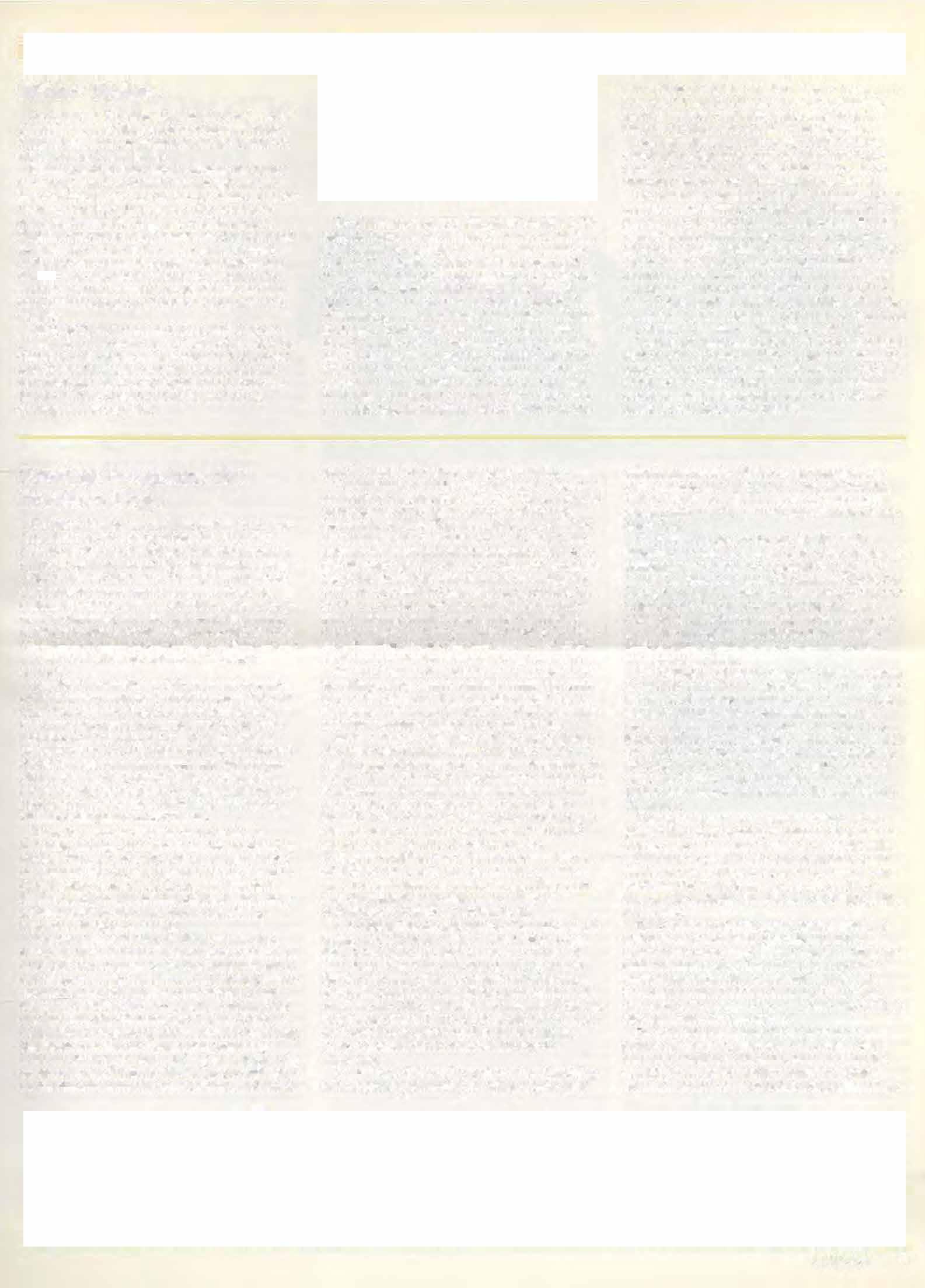
calories and protein. Bitches in late gestationand early lactation also need more energy and protein. This is best done by increasingthe protein and fat content wilh meat-based feed rather than by adding cereal feed.
Dogs alsocan gettoofat. An Englishstudy showed that about 20 percent ofthedogsseen byvet� erinarians were obeseand 3 percent weregrossly obese. Thefiguresare about the same at VHUP Dr. Donoghue explained that prior to putting a dog on a reducingdiet, it should be checked by theveterinarian to be sure that no underlyingdisease is present. When formulating a reducingdiet, one must think in terms ofcalories and the balance ofthe individual ingredients.
Dr. Donoghue discussed dogs withfrequent bouts ofgastritisand said that a low-fiber, Low-fatdiet may be helpful. She recommended rice as the most digestible carbohydrate, along with lean meat and the proper supplement package. Olderdogs present a lar,ger number in the population.Theirdietary needs are special. Dr. Donoghue feels that they should be fed a high-protein diet, similar to puppy food or a dense-dryfood, to meet theirneeds. She advised against very low-protein, geriatric diets available in the market.
During the question and answerperiodsheexplained that when weaning puppies thefood should closely approximate the content ofthe bitch's milk and be high in protein. Sherecommended a creepfeeding program where the pups have access to the food awayfrom the bitch. As they get used to it, theycan begradually changed overto a highquality puppyfood.
Or. Donoghue advised against supplementation with kelp, as the seaweed generally available in stores comes from manydifferent sources. Often the iodinecontent is very high and onecan gettoxic levels. Veterinarians haveseen problems in foal!. from mares which had been fed kelp.Thesefoals were born with goiters. Also, some kelp may contain high quantities ofheavy metals.
Dr. Donoghue reiterated the importance ofa properdietfordogs. tailored to their needs. One must pay attention to the individual dog when formulating a diet and consider whether it is lying around the house or whether it is a dog under stress.
'Maintenance refers to a healthy dog that is not growing. pregnant, lactating or stressed, and is living in comfortable surroundings.
Home-CookingDiets
Thedietsshownbelowhave been formulatedand developedbyDr. D. S. Kronfeld, University orPennsylvania, and are reprinted here with his permission.
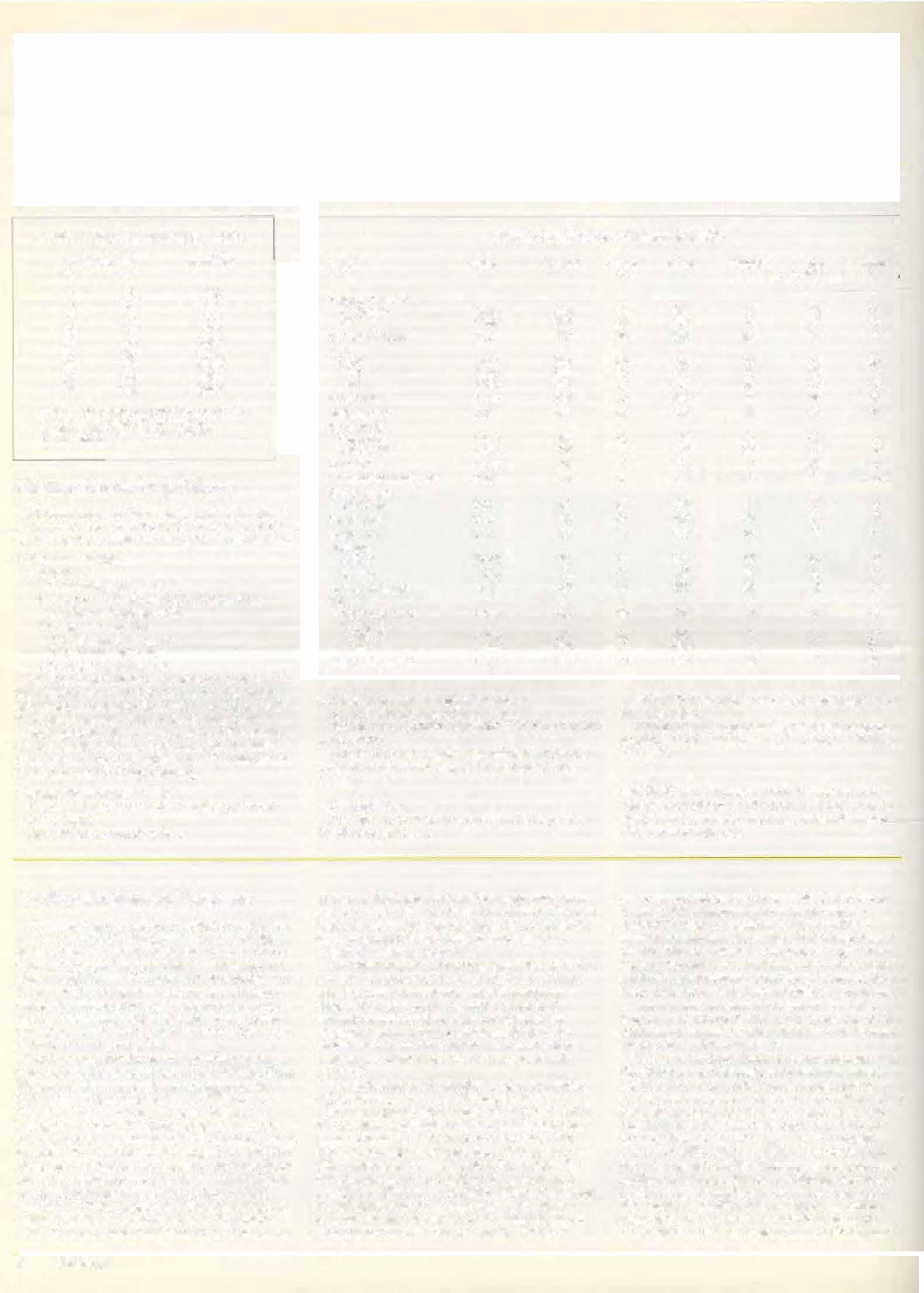
1. Maintenance Diet
Ingredients:
2/3 cup rice, uncooked
1/3 cup meat (beef, pork, lamb, boneless poultry,orboneless fish)
I/8cup(= I oz) liver
3 teaspoons bonemeal
2 teaspoonscom oil
1/2 teaspoon iodized salt
Cooking Instructions: Placerice, bone meal,corn oil, and iodized salt in 2/3 to I cup boilingwater. Stir, cover, and simmer20 minutes. Add meatand liver,stir,cover,andsimmer 10 minutes. Cool. Feeding lnstructions: The amount ofdiet shown aboveprovides800 kcal. This isasufficientdaily intakefora 10kg(about23 lb)dog.Thedietshould be fed inat least 2 divided feedings.
2. Bland/Hypoanergenic Diet
Use Jamb (trimexcessfat) or skinless poultry as source ofmeat.
Use chicken as source ofliver.
ArthroscopyinHorses
TheoperatingroomatNew Bolton'sC. Mahlon KlineCenteris quitedark,theonlysourceoflight beingatelevisionscreen whichshowstheinteriorof ajoint. Agroupofstudentslistensattentivelyas the surgeon explains theTV image and the procedure he isabout todo. The patient, ahorse,lies quietly in anestheticsleep. Arthroscopicsurgery is beingperformed. This scene, unthinkable six orsevenyears ago, happens almost daily at New BoltonCenterand atotherveterinary hospitals.
''Arthroscopynowisaroutineprocedurewhena horse with ajointinjury is presented,"said Dr. Dean Richardson,assistant professorofsurgeryatthe University ofPennsylvaniaSchool ofVeterinary Medicine. '*lt is oneofthegreatest advancesin orthopedicsurgery...Thearthroscope,arelatively new instrument, wasdeveloped in itsmodem formin the 1950s. Human orthopedicsadopted itwidely asa diagnostictoolinthemid-seventies,anditwassoon utilized inveterinary medicine. Beginningin 1981, it wasused fororthopedicsurgeryinlargeanimals. NewBolton Centerbegan usingthearthroscope on cUoicalcases in 1982,and now about200 arthroscopies ayearareperformedhere. Priortothe devel-
SOME COMMON DIET INGREDIENTS
3. "High'' Protein and .,High» Fat Diet Use II3 cup riceand2/3cupmeat.
NOTE: ALL OTlfER INGREDIENTS REMAIN AS ABOVE.
NOTE:Thisdietstillcontains800kcal. Only the proportions ofcarbohydrate, fat, and protein have changed.
4. Low Fat Diet
Useskinless poultry orverylean meat(e.g., beef heart) as meatsource.
NOTE: Do notreducecornoil;itprovidesessentialfattyacids.
NOTE: Thisdiet stiUcontains800 kcal Onlythe proportions ofcarbohydrates,fat, and protein have changed.
NOTE:Thesediets should notsubstituteforavisit with your veterinarian. Thediets,and furthervariations, have best results when used underthesupervisionofaveterinarian.
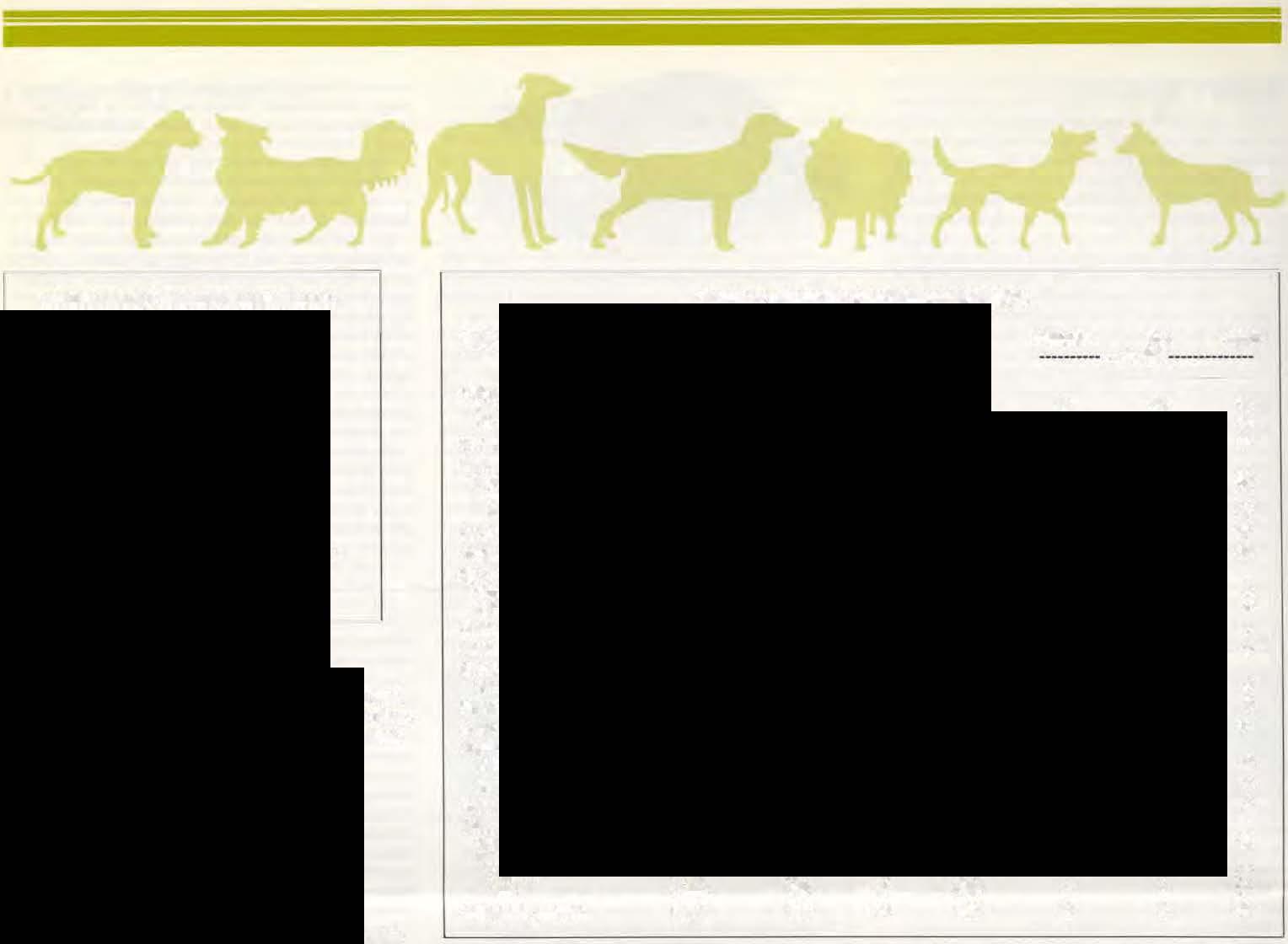
opment ofthe instrument, major surgery was nec£<ssary to remove chips or debris (rom ajoint. Thejoint hadto beopened widely, involvingmoretraumato thesurroundingtissues. Also,thisprocedurerequired alengthyrecovery time.
An arthroscopeis aslenderoptical instrumentthat permits thesurgeon to look into thejoint withou1 openingit,andto removesmallchipsandother debris."Thejointcan beaccuratelyexamined throughasmall incision,"said Dr. Richardson. "Lesionsandconditionsnotdetectable byradiographscan beseen.Theprocedure is notastraumaticas anarthrotomyand the recovery time is quicker."
The arthroscopeisinserted through aprotective, rigidsmall tubeor canula. Fiberoptics within the arthroscope permit illumination ofthejoint interior, andacameraattached totheinstrumentallowsthe clinician toexamine the interiorofthejoint. The lens is at an angleso that rotation ofthescopepermits awider areaofvisualization. The incision for thearthroscope is verysmall, as the instrumentis onlyfourmillimeters indiameter. When arthroscopy is performed,thejoint is keptfilledwith asterile fluid tokeepthesofttissuesfromcollapsingintothe jointspace.Thefluid runsconstantly tokeepthe
spacecleanofblood and tomaintaindistensionof thejoint. When instrumentsareused,theyare insertedthrough a second small incision. These instrumentsarespeciallydesigned with long, narrow shanks. Theycan be manipulated inthetightjoint space underarthroscopicvisualization. Thesurgeon needsbimanual dexterity and has to be trained inthe interioT anatomy ofthejoints. "With Lhe arthroscope you get amorecompleteviewthani:n openjoint surgery,"saidDr.Richardson.''Also,youcanmanipulate thejointand getdifferentviewsto helpevaluatetheextent ofthedamage.··
"We use it forbothdiagnosisandtreatment,''said Dr. Richardson. "lnfectedjointscan beexamined andflushed out, bonechipsordamagedcartilage can beremoved,and one can examine multiplejoints while theanimalisanesthetizedasingletime."He explainedthatthejointsmost oftenexamined are thecarpaljoints, thefetlock, a:nd hock and stifle joints. Thestine and hockjoints,in particular, are pronetoosteochondritisdissecanslesions, and these cartilagechipscauselameness. Although the majority ofhorses undergoing the procedure haveaspecificproblem identified beforesurgery, the arthroscopecan beaninvaluable tool in identifying the sourceoflameness when other meanssuch asradio-
In Memory of Philip B. Hofmann
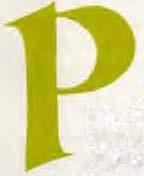
hilip B. Hofmann, a senjor member ofthe School's Board of Overseers, died on December 30. 1986, at the Miami Heart Institute. Mr. Hofmann and his wife, Georgia, have bad a long and close association wirh the Veterinary School and the University.
1n 1970, the Hofmanns established the Georgia and Philip Hofmann Research Center for Animal Reproduction at New Bolton Center. Mr. Hofmann, a graduate ofthe Wharton School, received the General Alumni Society Award of Merit and an honorary Doctor of Humane Letters degree from the University. The Wharton School presented him with the Wharton Gold Medal. and, in 1984. the Veterinary School bestowed on Mr. Hofmann and his wife its Centennial Medal.
For 43 years Philip Hofmann was associated with Johnson & Johnson, beginning as a shipping clerk and rising through the ranks of the corporation to chairman and chiefexecutive officer. A marketing genius and entrepreneur. he was a chief architect in building Johnson & Johnson to its present great scale and stature.
An avid horseman. Mr. Hofmann competed in the show ring, at hunter trials, and in three-day events and stadiumjumping. Together with his wife, Georgia, he established a racing stable, Wycombe House Stud, and bred and raced the champion sprinter. Gold Beauty, an Eclipse Award winner, and ftve other stakes winners.
Mr. Hofmann was a moving forcein American coaching competition, and he headed the first Johnson Park International Driving Show, held in New Brunswick, New Jersey, in 1970. He was the founder and president ofthe American Driving Society and served on an international committee to formulate international rules for driving competition. Re was electedto the Coaching Club of England, and in 1974 he was the first American driver to represent this country in worldchampionship driving competition. In 1973, Mr. Hofmann organized the Liberty Run, a two-day coach trip from Wall Street to Independence Hail. graphs and synovial fluid analysis have failed.
Dr. Richardson explained that anhroscopy is not a panacea. "It helps prevent thejoint problem from worsening. In order to alleviate the disease, we must determine the cause or underlying injury and eliminate it as much as possible." Arthroscopy has shortened recovery time and lessened the danger of infection or cosmetic blemishes as the incisions are very small. The animal is more comfortable and can resume its work or training sooner when compared to the traditional arthrotomy.
Tn veterinary medicine, arthroscopy is used primarily in horses. Occasionally, such surgery is also performed on cattle. It is not routinely used in the treatment of small animals as the joints are smaller, though recently researchers have employed the technique when studying changes in the stifle joim o£ dogs with damage to the ligaments.
According to Dr. Richardson, anhroscopic techniques may be expanded to include the use of the recently purchased laser in the treatment ofjoint disorders.. -H.W.
The Four-in-Hand coach. earring 2,000 pieces of mail and passengers,traveled along the old post route. The run was completed in 34 hours, with an overnight stop in Princeton. New Jersey.
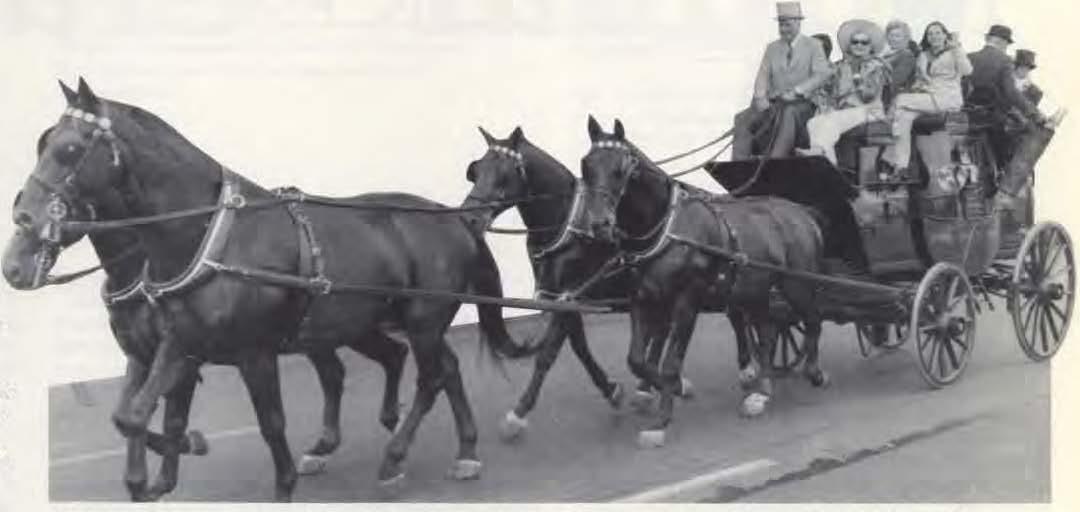
During nis long association with the spon of horses, Mr. Hofmann served as founder and first president of the U.S. Combined Training Association, director ofthe American Horse Show Association, chairman ofthe executive committee at Monmouth Park, president ofthe Florida Thoroughbred Breeders Association, trustee ofthe Thoroughbred Breeders Association, and member of the executive committee of the American Horse Council. He was also a United States Equestrian Team Honorary Life Member.
In 1986, Mr. Hofmann retired from competitive driving after suffering a heart attack while training for the Royal Windsor Horse Show in England. Queen Elizabeth 11 honored him at trus show for his service to the sport and presented him with a silvermounted, inscribed Four-in-Hand whip.
Philip Hofmann is survived by his wife, Georgia, and two daughters, Judith and Carol.
ContinuingEducation Cout"SesforAnimalHealth Technicians
This summer, Harcum Junior College will be holding two continuing education conferences for Animal Health Technicians. Both will be day-long conferences and will be held on Harcum's easily accessible suburban campus in Bryn Mawr, Pennsylvania.
The first conference will be held on SATURDAY, JUNE 6, 1987. Areas to be covered include: aquatic veterinary medicine, small animal neurology, diagnostic radiology, and zoonoses. Tuition for this conference is $25.
The second conference will be held on SATURDAY, JULY 18. 1987. It will be a bands-on conference in Intermediate Hematology Wet Labs, and participants are encouraged to bring problem slides with them. This conference is Limited to JO participants, so early registration is encouraged. Tuition for this conference is $35.
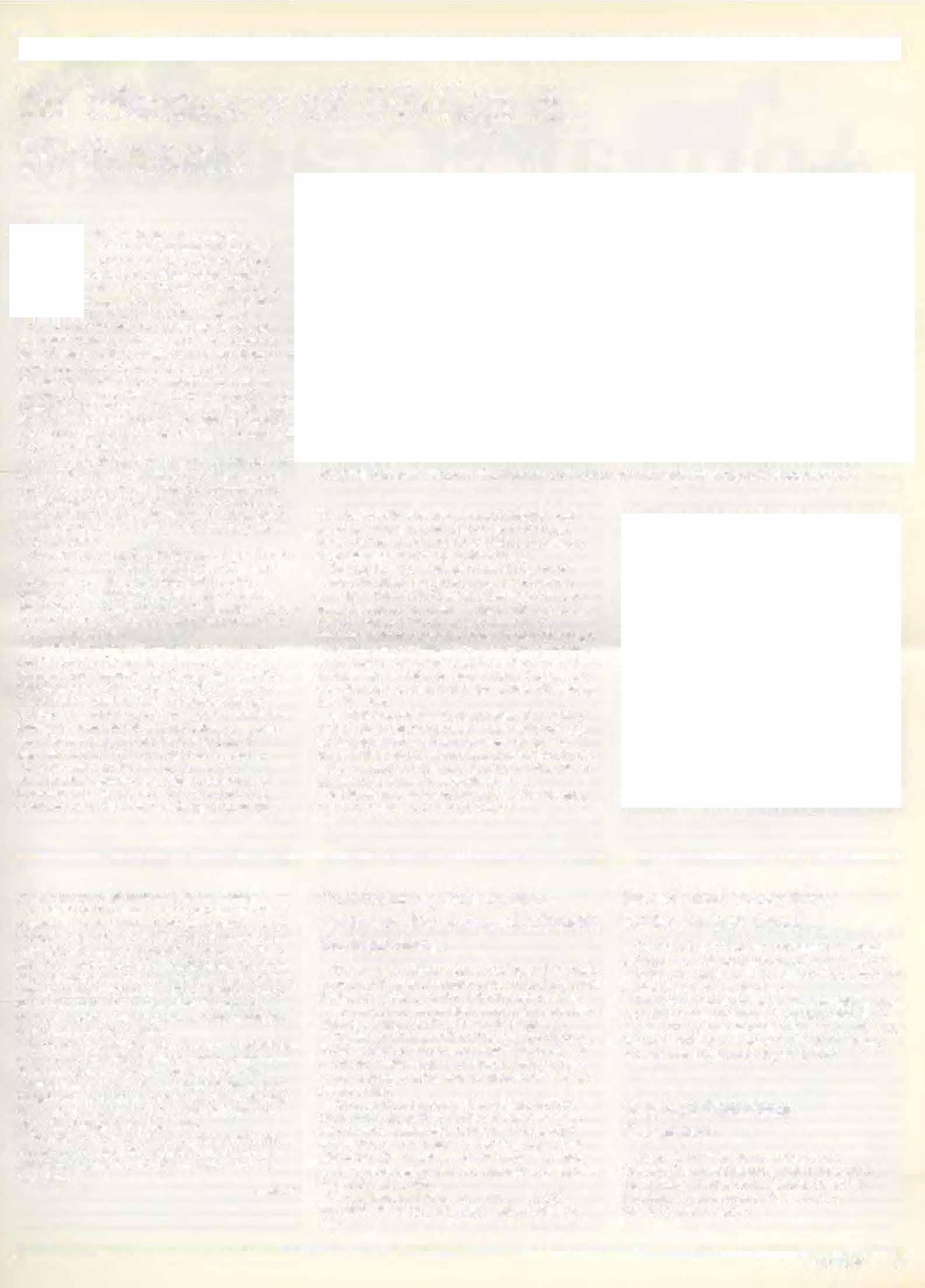
For registration information, please caiJ 215525-3554. The deadline for registration is May II, 1987.
IsraelandAnnaLive EndowmentFund
Dr. Israel Live (V'34) bas established the Israel and Anna Live Endowment Fund. Its proceeds are to be used annually towards support of a fourth-year student designated by the dean.
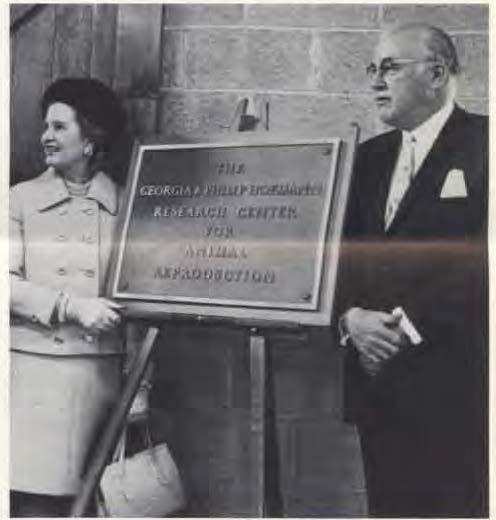
Dr. Live, emeritus professor of microbiology, has been on the faculty ofthe School since 1934. He is the first graduate ofthe School to receive a graduate degree. In 1936 he was awarded the M.A. degree. and he received his Ph.D. degree in 1940.
WarholPainting Donated
Henry S. McNeil, Jr., a member of the School's Board of Overseers, presented a painting by Andy Warhol to the School. The painting, part of Warhol's series "Images of a Child." depicts a parrot.
Mr.Philip Hofmann,whip.and Mrs. HofmannontheLiberty RunfromNew YorkCitytoPhiladelphiain 1973.TheCostofVeterinary EducationatPenn
Tuition fees have been increasingsteadily. At the present time. veterinary�tudeats at Pennsylvaniapay $10,890 yearly ifthey come from Pennsylvania and contract states; all others pay$12,950. This does not include tbe cost ofuving. The average age ofthe graduatingveterinarian is 29.5 years, and he or she basan educational debt (average) ofabout $40,000in some cases considerably more. This usually must be paid offin tenyears. Yet the average sala.t) the first years aftergraduauon IS around $22,000.
About as manywomen as mengraduateeach year and about halfare married, some with children. Applications have been declining, in partbecauseof the potential debt burden. We seem to be facing a situation where only thevery wealthy or tbe very poorcan afford a college education. Financial planning must begin early-even beforeenteringhigh school.
Scholarships are anenormous help to students needingfinancial help. Endowment funds make it possible to support qualifiedstudentsandhelp them avoid the stress and frustration that go with meeting loan payments while trying to learn.
Cryptorchidism
Cryptorchidism is a condition in whjch one or both testicles do not descend into the scrotum (unilateral or bilateral cryptorchidism). It often is mcor-

ProjectThreshold
The University's Strategic Plan for Computing, published in November, 1983, ca.Ued forexpansion of University support forcomputing ineducation, research, and administration. This plan was adopted by the University administration and has provided the gutdelioes for subsequent developments related to computing in the University.
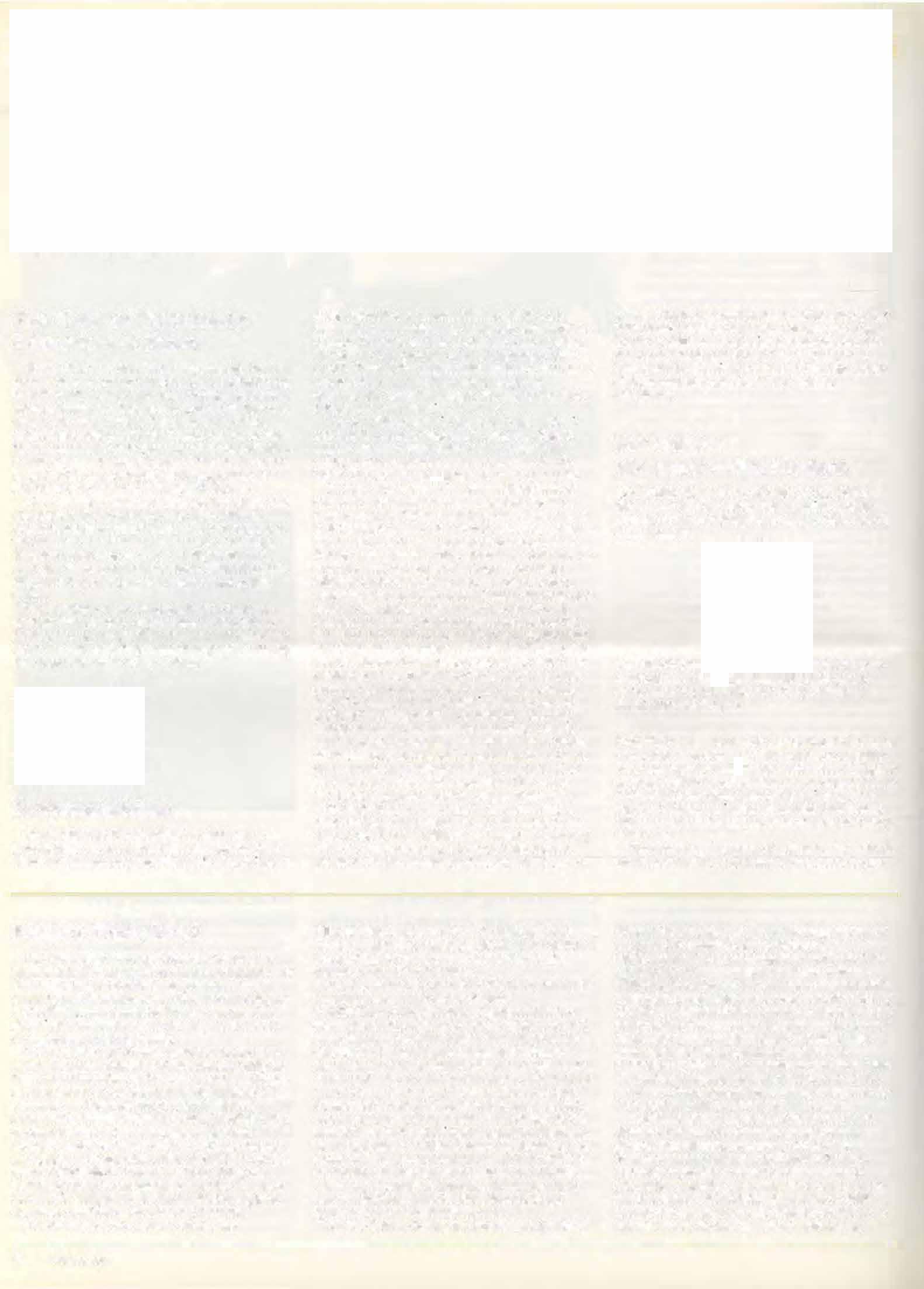
The President and Provost called upon the International Business Machines Corporation to help us begin implementation ofthe Plan by providingcompuler resources to the University. Theresult ofthis proposalwasTHRESHOLD, one ofnineteen Advanced Education Projects funded by IBM. Over the past two and a halfyears,thisprojectbas brought nearly six million dollars worth ofcomputing equipment to the University. As indicated by its name,THRESHOLD was intended to bringthe University from an environment in which computer use was the exception into one in which computers are widely used for instruction and research.
The following is an overview ofhow the
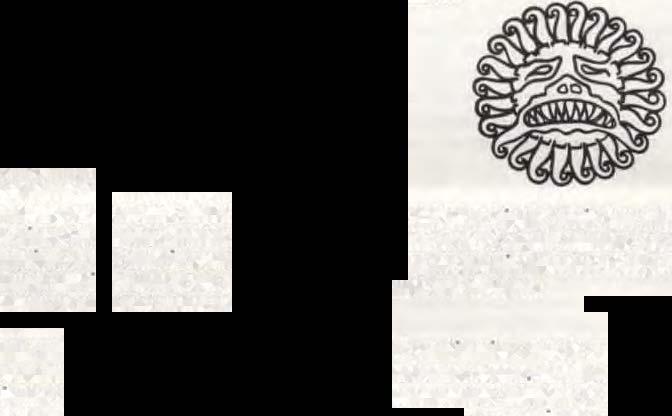
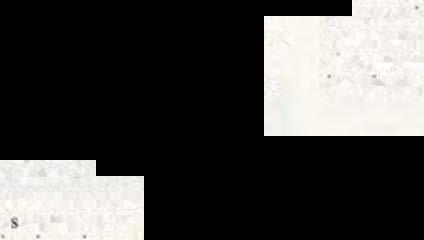
recUy referred to as monorcb.idism, which is an extremely rare condition in which only one testicle is present. The undescended testicledoes not produce sperm, but does producethe male hormone, testosterone. Thus, ifthe undescended testicle is allowed to remain wben the scrotal testicle is surgically removed, the an�mal will retain the physical and bebehavioral characteristiCS ofa male.
The condition occurs 10 horses (the affected ammal may be called a"ridgeltngj, andtheaffected animal acts like a stud rather than a gelding. In swine. the meat become unpalatable. as it does in boars. The treatment i cM1ration before maturity.
Ln dogs, thecondit1on 1s adisqualifying fault at shows. ll is fairly common and has been found in many breeds, although it seems to occur more often in thesmaller breeds. The overall prevalence is about 10 percent. It is considered an inherited condition. Family studies indicate that inheritance of thetrait is best predicted by an autosomal recessive model. Affected males must have two genes for the trait, receiving onefrom each parent. Males with only one gene are not affected but are carriers of the trait. Females, ofcourse, are not cryptorchid, but carrier females have one or two genes forthe trait, in which case 50 percent or 100 percent oftheir offspringwill also be carriers. Unilaterally cryptorchid males have nearly normal fertility, smcethe scrotal testicle can producesperm. Elimjnatlon ofthe trait ts possible only ifthe affected animal and lb parents are not used for breeding. Siblings ofaffected males may also be carriers. The retained testicle maydevelop tumors which sometimescause feminization. Medical treatment is not recommendedsinceit is oflittle value in inducing testiculardesoent and because of Lhe inheritednatureoftheconditton.Theowner should be urged not to use thedog for breeding.
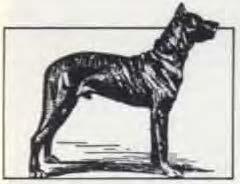
ln many species, both testicles aredescended at birth. Ln dogs. testes normally are descended at ten days ofage. but it is difficult to determine at that age since the testes are small. However, both testicles should be in the scrotum bythree months ofage. As
a rule ofthumb, an undescended testicle can be considered permanently retained at six months ofage. Therearedifferences ofoptnion as to whether castration is mdicated in young dogs to prevent the development oftcsucular tumors. Certainly. c�tration preven� the reproduction ofaffected mdiVIduals.
Preventive Measures-Reminders
COJ\'FTNEMENT IN A CLOSED CAR 01\ A HOT DAY can be deadly. This warrung is often ignored. When travelling with a dog, a wire crate is recommended.
THRESHOLD project, now in its third year and nearing completion, has impacted the use ofcomputing, particularly small system computing. in the School ofVeterinary Medicine.
Investigators at the School ofVeterinary Medicine havebeen awarded 14 grants through THRESHOLD. Applications in progress include development ofa registry ofgeneuc diseases ofpedigreed dogs, computeriz.ed three-dimensional reconstruction in tbe teachingofanatomical sciences, development ofcomputerized tutorials ofprinciples ofbiomechanics to veterinary students, and development ofa database on periodontal disease in dogs. Equipment for all ofthe projects has been received, tested, and set up. There remain some delays due to lack offunding foraddiuonal equipment (digitizers, video equipment) and forsoftwaredevelopment. The thrust ofthe projects, however, which is to develop innovative microcomputer techniques for teaching veterinary applications andincreasestudent exposure to microcomputers io educational settings, appears to be most successfulJy mel.
At New Bolton Center,the large animal facility in
ANTIFREEZE is h1ghlytoxtc but animals seem to be attracted to it. A small amount oo thegarage floor could be fatal 1fingested. Keep containers closed and out-of�reach.
RABIES vaccmat1on no"' is compulsory in Pennsylvaniaand otherstates A killed vaccineis available. The recommended schedule isvaccination ofpuppies at three months, re-vaccmation in oneyear. and then a"booster"every th.ree years. Any ammals under oneyear ofagevacc10ated forthe first timeshould receive a "booster"one}ear later, then at least ever}' three years.
The increasing frequency ofrabies in wild animals (raccoons, skunks, etc.) make!> it important to pro-
Kennett Square, several innovative programs are in progress. Dr. David GalJjgan, lecturer in animal health economics, has developed a nutritional herd monitoring program using spreadsheet software. This program allows adairy manager to enter milk production parameters and to evaluate theefficiency ofmilk production. This software is available to students so that they can have experience with the economic and health considerations of herd management. Spreadsheet programs have alsobeen developed by Dr. C. F. Ramberg for nutritional service and teaching applications in dairy and equine nutrition. The programs are currently being used by both students and practicing veterinarians.
In Philadelphta at the Small Animal and Basic Sciences Facility, The Canine Genetic Disease Information System, directed by Dr. Donald Patterson and coordinated by Patricia Green, is intended to provide a comprehensivesource of knowledge regarding many aspects ofcanine genetics. The system will include information on both known and suspected genetic diseases, as weU as on the occurrence ofthese diseases in various dog
teetdomesticanimalswhichmlgbtcomeincontact withthem.
HEARTWORM DISEASEoccun;throughout the UnitedStates.Infectionmaybepreventedbydaily dosef.of Diethylcarbamazine (DEC).Treaunent shouldbestartedatthebeginningofthemosquito seasonandcontinueforseveraJweeksafter. In warmerclimates,itshould begivenyearround. Havea hloodsamplecheckedformicre>falariabefore startingtreatment
Titenewdrug lvermet:tin, whichiseffectivewhen giveneverythirtydays,hasnotyetbeenapproved by theFDA. It asbejngtestedintablet form,andvery smalldosesareeffectiveagainstmicrofilariae. Some dogowner!> areusingproductsapproved forhorses and cattle. ltcannot berecommended fordogsunW ithaspasseda!ltestsforsafety
GetItRight!
IfDoctororitsabbreviation Dr. isul!ed beforea per!>on'sname,academicdegreesarenotgavenafter thesurname.Correctly,anameis writtenas Dr. JohnJonesorJohn Jones. V.M.D.
V.M.D.(Veterinariae Medicinac Doctoris)is awarded onlybytheUniversjtyofPeonsylvaruain the United States.The otherschoolsawardaD.V.M. Therequirement!.aremuchthel!ameforeach.
Thenoun vetermarian and theadjectivevnerinary oltenare used incorrectly.Avetennananisagraduateofaveterinaryschool.
TospaI'meanstoneuterafemalearumal-tbe pasttenseISspayed(not"spaded'1. Amaleis castrated.
Specialists
The AmericanVeterinary Medscal Association recogni1.eslouneenSpecialtyBoard!>. Afterfulfilling prercquisates(advancedtraining.experience,etc.) andpassinganexamination,aveterinarianbecomes aDiplomate(Board-certified).
TheAmerican BoardofVetennarv Practitioners h�Diplomate�inthreecategories Companion Antmal. Food Animal.andEquane.Thesrcertificate exp1resin tenyc:ars.whenarecertificationexaminationtsgiven.
OtherBoardsareVeterinaryToxJcology(the scienceofpoisons-theirsource.chem1calcomposition,action.testsandantidotes), LaboratoryAnimal breeds.Thedatabasewill ultimate!) offertheopportunityforveterinarystudents,veterinarians.and breederstohavemicrocomputeraccesstocurrent knowledgeinthefieJdofcaninegc:netics.•
fhegoalofDr. Richard Miselis'sproJectwasto implementcomputerizedthree-dimensionalreconstructiongraphicstoteachanatomycoursesinthe VeterinarySchool.Generally.two-dimensionaltissue sectionsortextbookdrawingsareused toconvey grossstructure, microstructure,and ultrastructurein anatomycourses. Dr._Miselishascreateda program whacbmputsthisinformation into thecomputer and reconstructsanimageinthree-dimensionalperspective, allowingmorerapidappreciationand retention ofthea!.pectsofthestructurebemgtaught. Astudentdatabaseinterfaceismdevelopment. Future goalsaretodeveloptb.isprogramtoaid ininterpretataonofamagesobtainedfromtechnologiessuchas CAT.NMR.and PETscans.
TheVeterinaryMicrocomputerLaboratory, directed by Dr. LarryGlickmanandcoordinated by LindaDomanski, willbeusedin both teachingand research.Themicrocomputerlaboratoryfacilitates
Medicine,Theriogenology(thestudyofreproduction in animal.!.). Anesthesiology.Dermatology,Veterinary Internal Medicine(Internal Medicine,Cardiology,and Neurology), Microbiology.Ophthalmology, Veterinary Pathology,VeterinaryPreventive Medicine.Veterinary Radiology, VeterinarySurgery,and Zoological Medicine.
TheAnnual DirectoryoftheAmericanVeterinary Medical A�socaationlists Specialty Boardsand Diplomatesaswellastheprerequir.itesfor examination .
BookReviews
TheEwm Guidefor Housetraining Yt1ur Dug b) JobMichaelEvans(HoweU Book House.230Park Ave ,cw York.. NY lO169. S11.95)
Th�isanexcellentbookforanyonegettinga puppyforthefirstume.Forthemoreexperienced ownt:r.therearenewideasandsomethingtobe learnedfromtheauthor'sprogressiveapproach. Housetrainingrequirestimeandhardwork,fora time.andthisbookcanbeaguidetosuccess. ll showshowtodothejobsothedogbecomesan accepted memberofthehousehold
Someexcerpts:
.. Problermarisewhenan indi"idualdog.either throughttsgeneticmakeupormistrainingb}its owner.comesto think ofilsetfastheleaderofthe pack.
.... Establisheyecontactonyourownterms if you'vebeenyellingatyourdogwhendealingwitha housctrainingaccident,resolveto:�toptoday.Try US,ingthehumanequivalentofabitch'sgrowl. .... YouRhould d.isciplineyourdog... themost you willneed.exceptincbroruccase�.isyourgrowlingtoneofvo1ceandeyecontact. Dascapline humanelyandonalevelthatthedogcancomprehend. becausethedisciplinemimicsthat ofthebitch.
.... lfyouwantyourpuppyorolderdogtoget houllt:tramed,yousimpl) mu�l confine thedog.
.
..fhe UmbilicalCord Method: Attachthedog's leash toyourbelt loopandgoabout yourday. You'lJ knowexactlywhereyourdogisandcanmoreeffectivelyavoid housetrainingaccidents. chedulesareimportant andit ises enlialto haveoneifyouwanttohousetraineffectively.
. . What Goes in ComesOut.. Selectagood food.
.. Housetrainingisn'tjustsomethingthatmagicallyhappens... butonce1t'sdone.at'sdone.
The Arabian: A Guidefor Owners bySharonByford (AiptnePublications.214 19thSt.S.E.. Loveland. co80537.$35.00)
ThasbookisaprimerfortheArabianhorse owner, whichcovershi'itory, bloodlines,care,breeding, and training.Therealso isbasicinformationon stable management,healthcare,grooming,genetics, etc.Thereissomethingwhich should beofinterest toanyonewhowould liketoreadabouthorsesin general.Arabiansinparticular.
Someexcerpts:
... TheArab1anhorseistheworld\oldestbreed. AllThoroughbredseventuallytraceto Arabian ancestry.
....The Arabianischaracterized byabeautiful, delicatehead,oftenwitha''dished"orconcaveprofile below large,prominenteyes;ahigh-set,arched neck�anda naturally high tailcarriage.
Credit forpopularizingthe Arabian horse throughout theworld belongstolheCrabbet ArabianStudofSussex,England.
AfewArabianswere1mpotted totheUnited Statesincolonialtimes.
TheArabian'saffectionforpeopleoften is attributedtoclosecontactbetweenthedesert horses andtbetrBedouinowners. foabusuallywere weaned quiteearlyandwereusuallydependentupon theirownersforcareandsurvival. Bedouinwomen andchildrenusuallyraisedtheyouJlghorses,feeding themcamel'smjlk.
.. . It hasbeensaidthatthe)respond moreLikepet dogs thanotherbreedsofhorses.
. TheloyaltyoftbeArabianhorsetoiuowners waslegendary 10 thedesert�acelebrated war mare wouldnotleavensfallenrider.Throughouthistory, theArabjanexcelledasawarhorse
. . • Arabaanshowsfeatureavarietyofperformance classes.suchasEnglishPleasure,WesternPleasure, Reining, Stock Horse,Trail, PleasureDriving, Formal Driving,Cutting,SideSaddle, Hunter,Jumper, Park Horse. Equitation,and NativeCostume.
. . . Arabianhorseswillcontinue tobeappreciated fortheirbeauty,inteUjgence.endurance.spirit,and a!fectionatenature. lt isuptotheowner�and breedersoftodaytoensure that theArabianhorseof tomorrowretainsthequalitiesforwhich it ha!ibeen valuedforthousandsofyears.
theuseofprogramsdevelopedbyother THRESHOLDinvestigatorsattheVeterinary School.ThefacilityconsistS oftwo lRM ATsand fourIBM XTs.connected bythe IBM PC etwork. Currently.thespreadsheetprogramsdevelopedby Drs. Rambergand Galliganareavailableiothe macrocomputerlaboratoryandareinusebyveterinarystudents.Otheractivities include incorporation ofclinicaldecisionanalysisintheveterinarycurriculum.teachingofepidemiologic methodsthrough simulationsofepidemics,andproviding microcomputer-basedstatisticalsoftwaretoaidin student research.
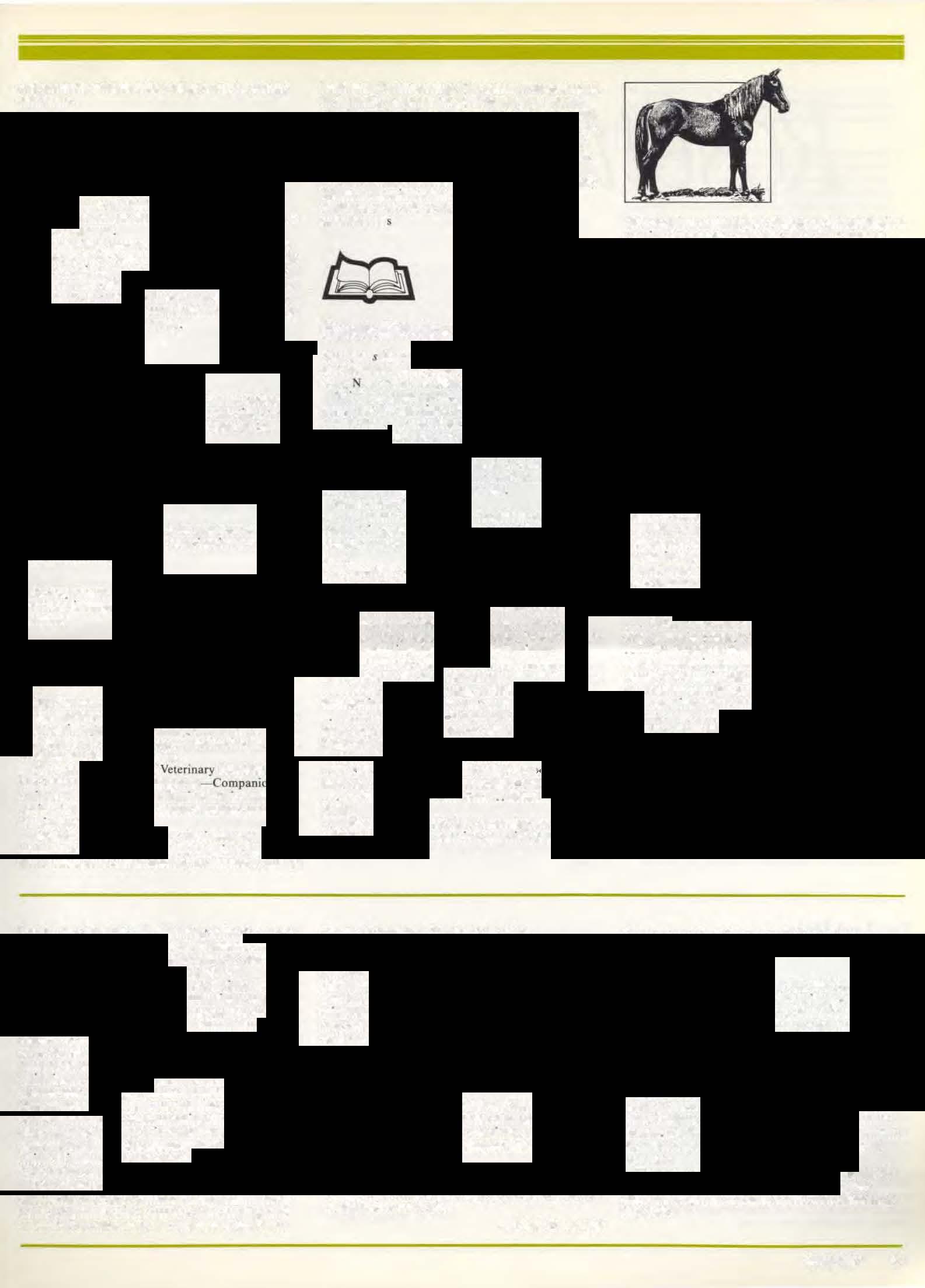
THRESHOLDhasprovided theVeterinaC) School thecapabilitytodevelopinnovativesoftware focusedatawidevarietyofvetennaryapplications andbasmademicrocomputingavailableloveterinarystudents.
•nrl'prajt>ctissupportedbyfund�from the American I<£nne/Club.Itwill reqw're three tofive years before it is a\•ailablefor genera/ use.
-Linda DomanskiGeneralAlumniSociety Trip
TheGeneralAlumruSocietyandtheCollegeof GeneralStudieswillsponsoranexcatingAlumni CollegeWeekendinCharleSton, SouthCarolina, during theSpoleto Festival.Tbhcomprehensivearts festivalwasfoundedbycomposerGian Carlo Menotti in 1977. Afullprogramofsightseeing throughoutthischarmingcitywill be included,as wellasaperformanceofchambermusic;"footprints"bytheJazz/TappEnsemble:"'ARoadto Mecca."starringanddirectedbytheplaywright, Athol Fugard;andtheopera"Salome"'byRichard Strauss Dr. EugeneNarmour,associateprofessorin tbemusic department,willlecturethroughoutthe weekend.
Thegtoupwillstayat thefamousMillsHousein Charleston.ThedatesareMay28-31.Formore information.pleasefeelfreeto call Rhea Mandellat 898-6940.
Dr. Jorge Ferrer, professorofmicrobiologyinClinicalStudies,receivedatwo-yeargrantfromthe RobertJ. Kleberg,Jr., and HelenC. Kleberg Foundationfor''Studiesonthecontrolofgeneexpression inthebovineleukemiavirus(BLV)anddevelopment ofaBLVvaccine."
The School of Veterinary Medicine issupponingthe ColloquiumonRecognitionand Alleviationof AnimalPainand Distress.sponsored bytheAVMA onMay 15 to 17 inChicago.
MembersoftheBedfordCountyHolsteinAssociationtoured New Bolton Center in March.
RecentlyJamesD. Shaw,SilverSpring,MD,senta donationtotheFriendsoftheSmallAnimal HospitaL Inanattached noteheinformedusthathe passedhisBoyScoutBadgeattheveterinaryhospitalin 1925.
Dr. Robert J. Orsher (V"79), assistantprofessorof surgery,receivedanawardfromtheAmericanCollegeofVeterinarySurgeonsforthebestclinicalresearch paperbyaresident.Thepaper,"Oinicaland surgical parametersindogswith perinealherniaanalysisofresultsofinternalobturatormuscle transposition,"waspublished in 1986 in The Journal of Veterinary Surgery.
Dr. Adrian R. Morrison, professorofanatomy,bas beenawardedaNATOgrantforcollaborative researchattheInstituteofHuman Physiology,UniversityofBologna,Italy.Dr. Morrisonspokeata symposiumon..ThermoregulationandSleep"ata meetingoftheEuropeanSleepResearchSocietyin Szeged,Hungary,andparticipated inaworkshopon "CellularMechanismsofNeuralIntegration,''sponsored bytheInternationalBrain ResearchOrganizationinMontevideo,Uruguay. Dr. Morrisonisacoorganizerandmemberoftheexecutive boardofthe recentlyestablished HumanClinicalSleep Research Center, which hasreceivedinitialfundingfromthe EleanorN. DanaCharitableTrust.
Dr. Sherbyn Ostrich (V'63) wasnamedVeterinarian oftheYearbythePennsylvaniaVeterinary Medical Associationattheassociation'smeetinginOctober.
Dr.LeeDies
Dr. DonaldG. Lee,formerprofessorofanatomy andassociatedeanoftheVeterinarySchooldied on February 16, 1987. Amemorialservicewasheld on February 20thinUnionville, Pa.
Dr.LeegraduatedfromtheSchoolin 1936 and joinedthefacultyasinstructorinanatomyin 1937. Heimmediatelyassumedaheavyteachingloadin grossanatomyandhistologyandcontinuedlhisuntil the 1960s whentheLaboratoryofAnatomy expanded. Dr.Leebecameprofessorin 1951, andin 1957 hereceived ajointappointmentasprofessorin theGraduateSchoolofMedjcine. Hewasappointed associatedeanin 1962 andserved inthiscapacity until 1973. Duringtheseyears,hewasheavily involved incurriculummatters,andbespentconsiderabletimeinstudentcounseling.
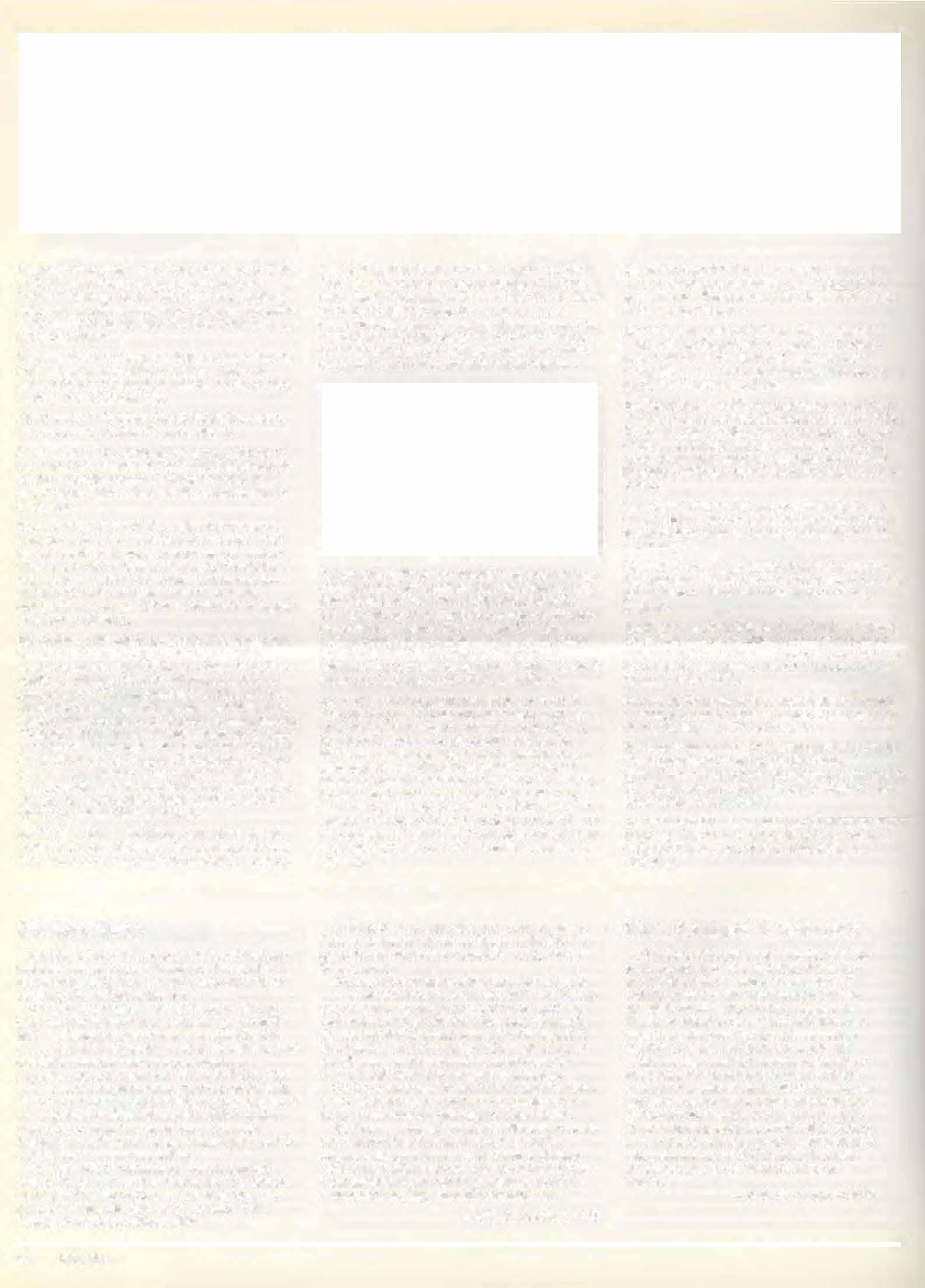
In additiontohisteachingandadministrative duties,Dr. Leeservedonmanyfacultycommittees, especiallythe LibraryCommitteeandtheAdmissionsCommittee. HeservedasSecretaryofthe FacultyForumfrom 1944 to 1962.

Dr. M. Josephine Deubler (V'38) wasawarded the FidoWomanoftheYearAwardduringaluncheon foUowingtheWestminsterKennelClubshowinNew Yor.k. Dr. Deublerisonlythefourthwomanto receivethisprestigiousawardforthethirdtime.The award is presented byGaines Dog CareCenter,and nomineesarevotedforbyjudges,dogshowexhibitors.writers,and otherprofessionalsindogdom.
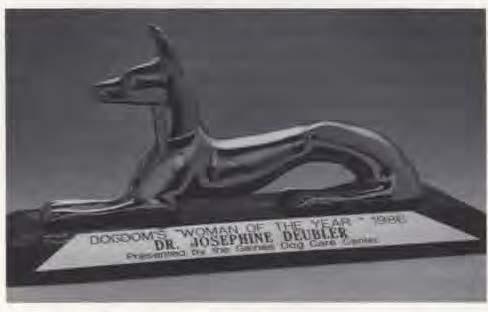
Dr. R. Lee Pyle (V'6S) basbeennamedassociate deanfordevelopment,facilities.andinformation systemsattheVirginia-Maryland Regional College ofVeterinary Medicine.
Dr. Wilson Haubrich (V'37) wascitedatthe 1986 EasternStatesExpositionasAgriculturalAdventureroftheYear. Dr. Haubrichwas honored in recognitionofhislongcareerand advancemem in thefield ofbovinereproduction.
Dr. Roger Smith (V'57)waselectedpresidentofthe PVMA. President-electis Dr. Kenton Stokes (V'68). Dr. Palace Seitz (V'30) servesassecretary-treasurer oftheorganization.and Dr. Charles Clark (V'61) servesasassistantsecretarytreasurer. Dr. Richard Detwiler (V'48) waselected alternatedelegatetothe AVMA.
Dr. Katrin Hinrichs, lecturerinreproduction,presented atalkattheAnnual Meetingofthe International EmbryoTransferSocietyin Dublin, Ireland. inJanuary.
TheSchoolofVeterinary Medicinewasapresenceat theDecember 1986 meetingofthe AmericanAssociationofEquine Practitioners.Speakersfromthe School'sfacultycomprisedL 13.5 percentofthenumberoftotalspeakersatthismeeting.TheNew Bolton Centerfacultymembersgivingpaperswere Drs. Jill Beech� Thomas Divers, Grant Frazer, WiJiiam Moyer. David Nunamaker, Virginia B. Reef, Raymond Sweeney, and Robert H. Whitlock. Dr. Jill Beech (V"72), associateprofessorofmedicine.wasaspeakeratthe5thInternationalConferenceon EquineVeterinary MedicineatSao Paulo. Brazil,inDecember.AttheAAEPmeeting,Dr. Beechwassessionschairmanforthesessiononrespiratorydiseases.She haspublishedanoriginal reporton"Familial studiesofadegenerativedisease in thecentralnervoussystemin MorganHorses," whichwaspublishedintheJanuary L987 issueofthe American Journal of Vetermary Research. Dr. Beech also particjpatedandcha1red asession attheSecond Winrock WorkshopforAnimalHealth Researchin January.
Dr. Robert Kenney, professorofanimalreproduction,presented aposteratthesame meeting. Healso presentedtwo talksattheUniversityofGhenL Belgium�
Dr. David Kronfeld, Elizabethand William Whitney Clark ?rofessorofNutrition,presentedaseriesof seminarstotheNewZealandVeterinaryAssociation inAuckJand, Wellington,and Christchurch,New Zealand,in November.
Dr. Sue McDonnell, post-doctoraltraineeinreproduction. presented aseminaratthe EquineSymposium inLexington, KY.in December.
Dr. David Nunamaker (V'68), Jacques JennyProfessorofOrthopedicSurgery, and Dr. Dean Richardson. assistantprofessorofsurgery,receiveda U.S.patentfortheirexternalfixationdevicedevelopedat New Bolton Center.
Dr. Robert Eckroade, associateprofessorofpoultry pathology,hasbeennamedas Headofthenewly designated LaboratoryofAvian Medicineand Pathology.
In 1960, Dr. LeespentoneyearattheVeterinary School, UniversityofBristol,England. ln 1977, be spentsixmonthsat BenGurionUniversityofthe Negev,Israel.
Dr. LeewasamemberoftheAmericanAssociationofAnatomists,AmericanAssociationofVeterinaryAnatomists,WorldAssociationofVeterinary Anatomists,andthePhiZetaHonoraryFraternity. HereceivedtheLindbackAward forDistinguished TeachingfromtheUniversityofPennsylvaniaand theDistinguishedVeterinarianAwardfromthe PennsylvaniaVeterinary MedicalAssociation.
Dr. Leeretiredin 1979 andbecameEmeritusProfessorofAnatomy. Inretirementhecontinuedto haveakeeninterestintheaffairsoftheSchool.
Dr.Leewasreveredbystudents. Hewasanexcellentteacherwhoselectureswerealwayswenprepared. Hespentinnumerablehoursin dealing withstudentaffairs. Hewasaquiet,extremelycourteousindividualwhoexhibited uncommongood judgmentindealingwithdifficultproblems.
-John
E. Martin, VM.D.Mrs.SamuelF.Scheidy
Mrs.SamuelF.(Henrietta}Scheidydiedon February 19, 1987. Mrs. Scbeidy,wifeofthe lateJ)r.Scheidy,wasactiveinanumberof societiesrelatedtotheveterinaryprofession. especiallytheauxiliaryofthePennsylvania Veterinary Medical Association(PVMA).She playedaleadingrolein theestablishmentof thePVMAAuxiliaryStudentLoan Fund, whichhasbeenusedtohelpmanystudentsat Pennfinancetheirveterinarymedicaleducation.Shewasa1sovitallyinvolved intheAuxiliaryoftheAmericanVeterinary MedicalAssociation(AVMA)andhadaspecialinterestin thestudentchapteroftheAVMA(SCAVMA) atthisschool. AplaquehonoringMrs. Scheidy anddedicated bythePVMAAuxiliarywas placedLastyearinthestudentloungeat VHUP
-JohnE. Martin, V.M.D.
Grants from the Reseruch Foundation ofthe University of Pennsylvama \\'ere received by Dr. Peter O<Mbon. c:Usociate profe:.'>uc of anatomy, Dr. Ste�en J. Fluharty. assistant professor of anatomy; and Dr. Ricbard R. Miselis (Vi3). associate professor of anatomy.
Dr. Colin Jobn�Cone. <J$sociate prolessor of parasitology m ep1demtOiogy and health economics, bas been named director of the Center for Ammal Health and Productivh:r at the School. Dr. Johnstone was also reappomted as a member of the Pennsylvania Race Horse Testing Program.
Dr. Stephen P. Schiffer. assistant professorof Laboratory animal medicine. has been reappointed to serve on the Institutional Animal Care and Use Committee. Dr. David K. Detweiler (V'42) also aocepted a reappOintment to that commiHee.
Dr. Linda OeChambeau (V'SO) received the ''Good Doctor Award" from the Maryland Veterinary 1\,iedical Association in November. This newly created award, given for samaritan service to the animal community. was presented to Dr. DeChambeau at the annual meetmg of the as�ociatioo. Or. DeChambeau i� tbe fi�t recip1ent of the award
Dr. Daniel Cohen. VJ�ahng profes'>or ofepidemiolOg). has been re-appoinled to serve his 12th year on the E\pcn Panel in Vetennary Publ1c Health of the World Health Organization
Dr. Loren Evans. profcl!�or of surgery, presented a two-day semmar to the Argentine Equine Practitioners Association m Buenos Aires in December Dr. Evans also presented three papers at the Eastern States Veterinary Meeting in January in Orlando, FL.
Or. Robert Whitlock, Marilyn M. S1mpson Profes:.or in Equine Medicine, and chairman, Department ofClinical Studies (NBC), presented a paper, "Potomac Horse Fever: l)iagnol>iS and Treatment." at the United States An1mal Health AssociatiOn in Loru.s'1Ue. KY. m October
Dr. Debbie Wilson. lecLUrer 111 ane!\thesia. presented an abstract at the ACVA meeting 10 Las Vegas, Nevada. She also became cenified for advanced cardiac life support (ACLS).
Dr. £llen l. Ziemer has been named acting director ofthe Climcal Luboratorv at :-.lew Bolton Center through July 3I, 1987.
Dr. Raymond Zemjans. professor and Head of the Dtm1on of Large Antmal Clinical Services, CoUege o( Vetennary Med1cine. Untverslly of Minnesota, St. Paul. MN, has recently accepted a position of visiting professor of theriogenology tn the Department of Climc.ctl Studiel>. New Bohon Center. for the period of one year. January I through December 31. 1987.
Scholarships

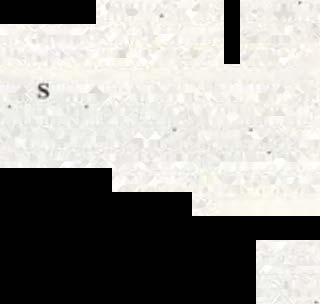
Hill's Pet Products. Inc. has pro\lded four scholarships in the amount ofS1.000 each The recipients are Anne Crump. a fir:-,t-year :-,tudent, Dorothy Hayes, a !lecond-year J>tudenl. Tbom� Hufnagel, a third-year iitudcnt: and Diane •ot, a fourth-year student.
Buban Gregor), a fourth-year student. is the recipient of a $1,000 schola�hip awarded by The Llovd':-. Underwmers, Uovd·s Brokers and Kentud AgentsJ(•int Equine Research and Education Pro-gram Comrruttce
The Greater Philadelphia Dog Fanciers Assoc1ation, Inc. made a contributton to the School's scholarship fund.
Edward Chrosc:inski, a thtrd-year student. lS the recipient ofthe $895 scholarship awarded by the Mid-Susquehanna Kennel Club. The Union County
Max A. Van BusiUrk (V'56) has been elected second vice-president of the United States Animal Health Asl.ot.,atioo. John .ShooL(\-"48) bc�o:ame the new secretary of the organization.
Among the newly elected AAEP officers and executive board members are David A. Meirs (V'54), Gary A.Lavin (V'62), and Clyde J. Johnson (V'62).
Dr. CoJjn E. Harvey. professor ot surgery at the School and adjunct professor ofsurgery, School of Deoustry, wasenrolled as a Charter Fellow ofthe Academy of Veterini!ry Dentistry followingcompletion of the first credentials and examination process of the Academy. He also waselected secretarytreasurer of the organiLation.
Dr. Harvey presided ut the inaugural meeting of the International Veterinary Ear, Nose, and Throat Association {IVENTA) in Paris, France, in December 1986. The organiz.ation was founded by Drs. Harvey and Venker-van Haagen (of the University of Utrecht, The Netherlands). A second meeting of IVENTA is !>cheduled to be held during the Eastern States Veterinary Meeting in Orlando, Florida. in January 1988.
In April 1987, Dr. Harvc)' Will present the first BSAVA Memorial Lecture.on the subject of Ear Surgery, during the Briti�h Small Animal Veterinary Associauon Congres!> in London. He will also lecture on vetennary denlastry at the French and Dutch small ammal veterinary association meetings in 1987.
In February 1987. Dc. Harvey was guest of the Japanese Antmal Hospital AssociaLion, presenting seminars and wet-labs on vetennary dentistry in Tokyo. O!>aka. Fukuoka, Yatsushiro. and Kawasaki.
From September 1987 to August 1988, Dr. Harvey will be on scholarly leave at the University of Liverpool as a Visiting Professorjotntly in the Veterinary and Dental Schools, conducting collaborative studies on spontaneous periodontaldiseases ofdogs and cats. Because of this commjtment. he recently resigned after 5 years as editor of Veterinary Surger)� thejournal ofthe Amcm.an \ollege of Veterinary Surgeons.
Dr. Leslie G. Herr (V'86) has been appointed as a veterinary medical officer by the Food Safety and Inspection Servtce of the United States Department ofAgriculture. Dr. Herr will work Wtth the meat and poultry �pecuon program. and sht: will be based in Minneapolis.
Dr. Donald Brown ha' been appointed lecturer in cardiology dunng Dr. Klllght'l> scholarly leave.
Dr. Harry Rozmiartk hru. been appomted professor of Laboratory unimal mtdicine tn tbe Department of Clinical Studte�. Philadelphia. He is Chief. Section of Laborawry Animal Medicine. and the director of University Laboratory Animal Rel>ources.
Dr. James S. Wilson, a veterinarian and a Iawver, has been appoimed lecturer. He will be teaching the practice managemcnr and professional foundations cour es.
Dr. Jonathan E. Palmer (Vi7). assistant profel>SOT of medicine. has been appointed associate director of the Unit of Laboratory Animal Resources at New Bolton Center. Dr. Palmer received continued funding from the Amencan Quarter Horse Association for research on Potomac Fever. He also presented seminars at the Equine Symposium in Pittsburgh, the ACVIM and the PVMA meetings.
Dr. Virginia Ruf, assistant professor of medicine. was a visiting lecturer in ultrasonography in Sweden and the Netherlands in October und November. She received a grant from the American Aorse Show Association for a study on "Diagnostic ultrasound for tendon and ligament injury in the distal extremities ofperformance horses "She also recenred a grant from Cardio-Data System� to study "24-bour continuous EKG monitoring in the horse.''
Dr. Corinne .weeney, assistant professor of medicine. parucipated tn the First International Workshop on Rhodocuaus l'qui m Ontano, C.anada. Dr. Sweeney received agrant from Transp1ration Technologies, Inc. forresearch on equine exercise induced pulmonaJ') hemorrhage.
Dr. Raymond W. s�·eeney (V'82) received fuodmg from Travenol Laboratories to study the nutritional management of hor&e:. and calves with gastrointestinal disorders He also received a Merck Arumal Health Education grant.
Dt. Wendy VaaJa (V"80). director of the neonatal mtensive care unit, bas developed a program for veterinary students, nurses, and medicine staff in equine neonatology. She received a grant from AgriTech. lnc. to study ''Testing for failure of passive transfer in the horse.··
Dr. Alan Beck. adjunct associate professor of animal ecology h� been appointed to the hoard of directors of the Pennsylvama SPCA.
Dr. Robert J. Rutman, professor of biochemistry, was the general chairptrson of the TntematiooaJ Pan Afncan �utnt1on Conference held 1n November in Philadelphia. Dr. Rutman w� invited to participate in the lnternauonal Sympostum on Sctence, Technology and Development tn New Delhi. India. in March.
Dr. Michael I. Kotli koff, assistant professor of pharmacology. recetved a grant of $35,000 from the American Lung Association and a gram ofSJ05,000 from the National Institutes of Health to study "Ton channels in airway smooth rnuscle."
Kennel Club awarded a S!iOO loCholarshlp to Nancy Hallam. ajunior.
A $1,000 contribution to the "itudent �cholarship fund h<b been made by the New Jersey Sports and Exposition Authority 1n memory ol Dr. John F. Nugent (V'SO).
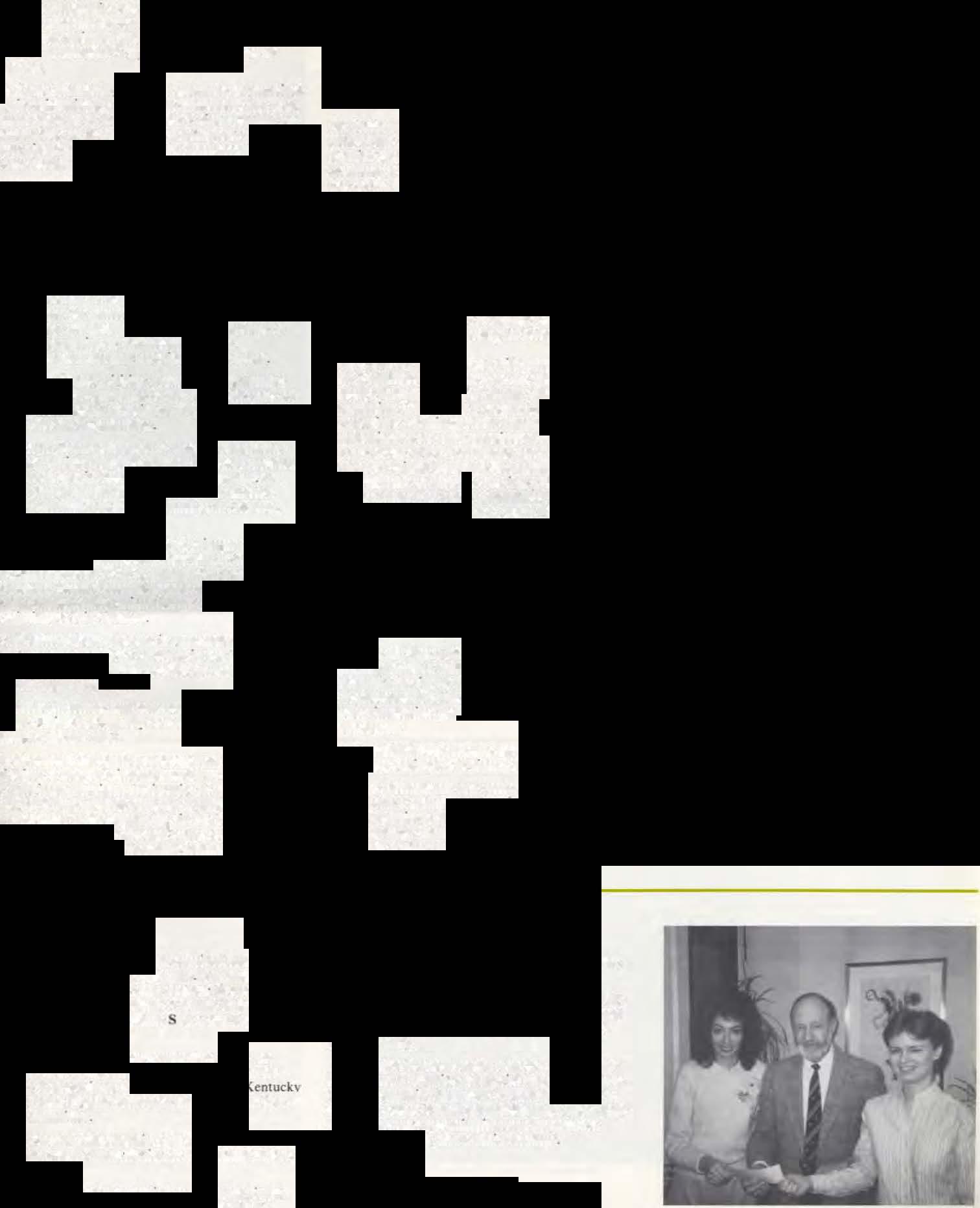
Jacqueline Burke. a senior student. received the Dr.Samuel F Schetd)' Memonal Scholarship from the Pennsylvama Veterinary Foundation. The Dr. Samuel B Guss MemoriaJ Scholarship. made a"ailable by tbe same organllatlon, was awarded to Susan Colbas.'>&ni. also a !tCntOr student
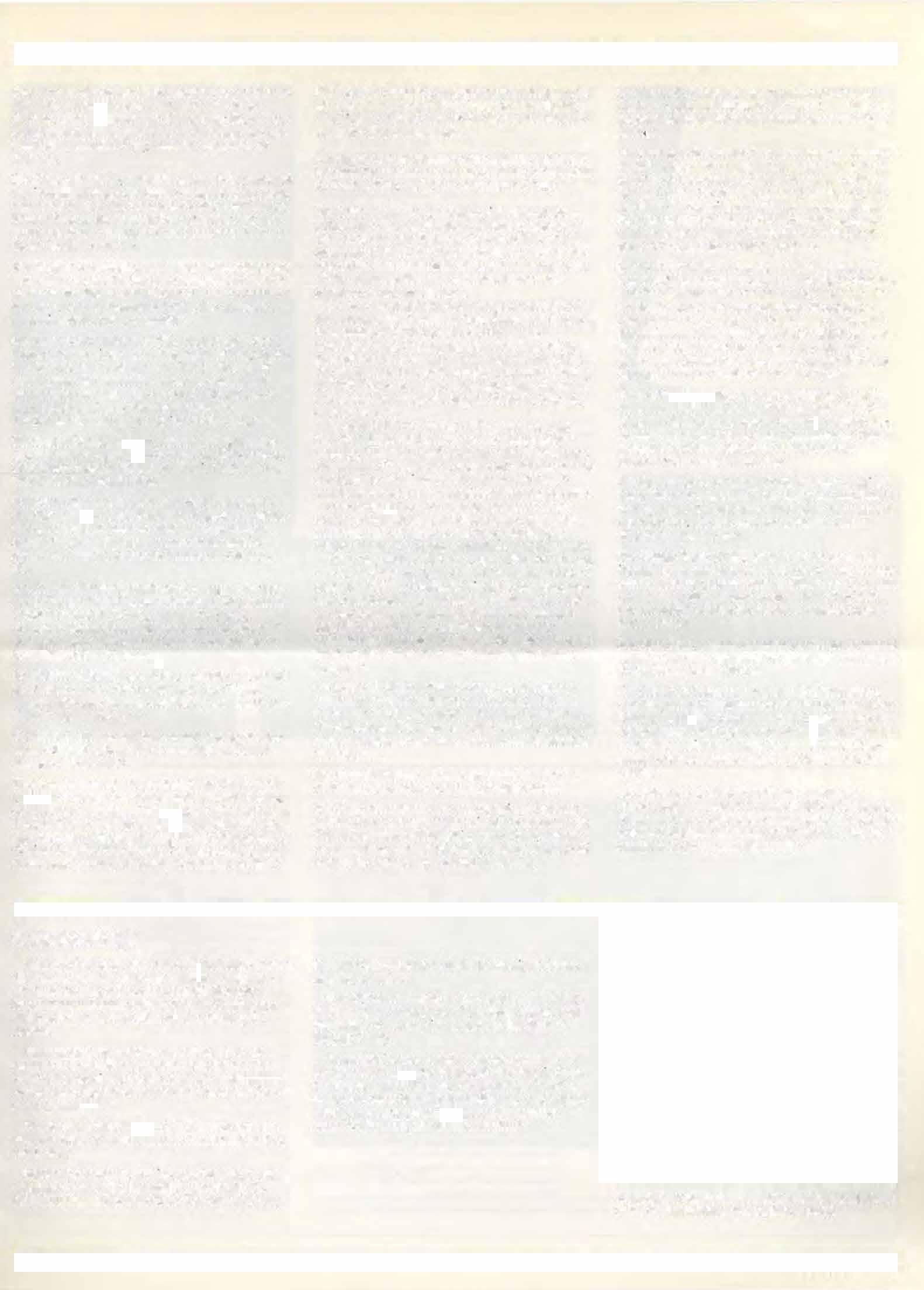
TheClassof1937ASpecta�50thRe�on
THE NEED: Renovation ofseveral rooms inthe Small Animal Hospitalto provideovermgbt accommodations forvisiting faculty and ashowcase forantique veterinary books and instruments.
THE RESPONSE: $22,000 raised infour months by 22 membersoftheClass of1937
The RESULT: THE CLASS OF 1937 ALUMNI ROOM.
1987PennAnnual Conference
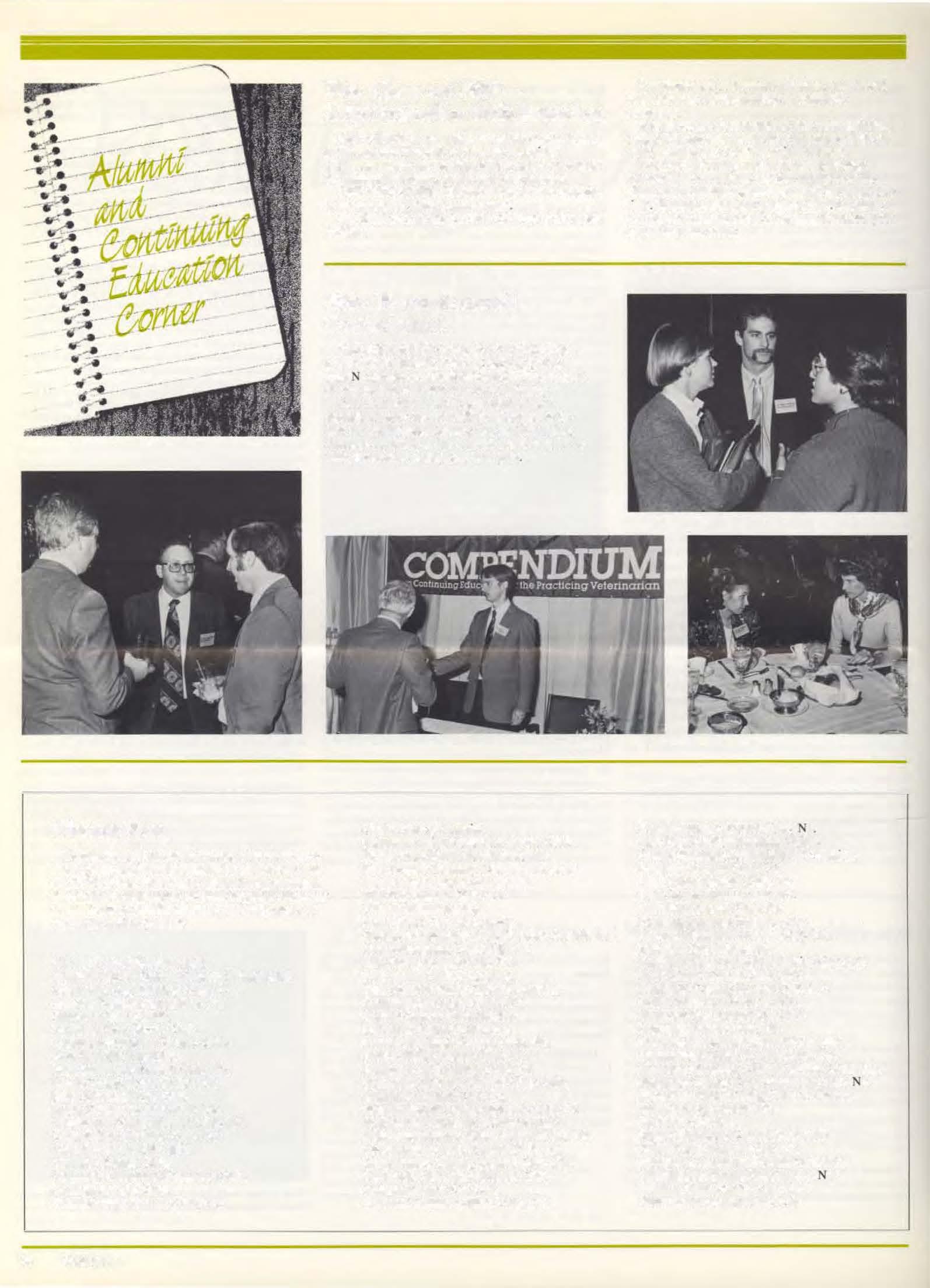
THANK YO TO THE 650 VETERINARIANS AITENDING THE SCHOOL'S87th PEN AJ'IINUAL CONFERE�CEI Thesupport ofour alumni thisyearwasoverwhelming. Drs.Tom Diversand Chuck 'Iewton are already at work on our 1988Conference. tobe held on Wednesday,January 27, and Thursday. January 28. 1988. atthe Adam's Mark Hotel. We look forward to seeingyou next year
Twofurnished bedroom:>,a kitchen,andshared bath allowingvisitingfacultyan attractive apartment.
A hand-made displaycabinet has beenspecially designed to provide spacefor arotatingexhibit of antique veterinary books and mstruments.
The Dean, Faculty,and StudentsgratefuUy acknowledge the supportofthe membersofthe Class of 1937 whosegenerosity made the room posstble Special thanksto Dr. Harry F. B Bartolett. Dr. David Crisman,and Dr. Sydney Ro!>enbergfor organi2ingthiseffort.
ThankYou
Duringthepast 14 months many clubs have providedgenerousfinancial supporttothe School and to VHUP. Thesefunds have enabled ustopurchase much needed equipment, providefinanciaJ aid to our students, studyspecificdiseases, and helpmanyof oursmallanimalpatients.
Wethankthefollowingclubs:
AiredaleTerrierClubofGreater Philadelphia.
Allentown DogTraining Club. PA.
Altoona KennelAssociation, PA.
American Boxer Club.
American FoxTerrierClub.
American SealyhamTerrierClub.
American ShiTzu Club.
Back Mountain KennelClub, PA.
BerksCounty KennelClub, PA.
Black Diamond Cat Club.
BucksCounty Kennel Club, PA.
BurlingtonCounty KennelClub. NJ.
Capitol DogTrainingClub, DC.
Carroll Kennel Club, MD.
Catoctin KennelClub.
CentennialShetland SheepdogClub.
ChesapeakeCat Club.
ChesterValley Kennel Club. PA.
CollieClubofAmenca.
Delaware Valley YorkshireTerrierClub.
Devon Dog Show Association, PA.
Dog OwnersTraining Club of Maryland.
Eastern lrishSetterAssociation.
Elm City Kennel Club, CT.
Finicky Feline Society.
Great Dane ClubofAmerica.
Greater Philadelphia Dog Fanciers AS!>ociation.
Green Mountain DogClub, VT.
Harrisburg KennelClub. PA.
IrishSetterClub ofAmerica.
Jack RussellTerrierClubofAmerica.
Kanadasaga Kennel Club, NY.
Kennel Club ofPhiladelphia.
Lancaster Kennel Club, PA.
Laurel Highlands Kennel Club, PA.
Lehigh Valley KennelClub, PA.
Luzerne DogTrainingClub, PA.
MahoningSbenago Kennel Club, OH.
Mantatee Kennel Club. FL.
Meadowbrook CockerSpanielClub,CT.
Mid-Jersey Labrador RetrieverClub.
Mid-SusquehannaValley Kennel Club, PA.
Monmouth County Kennel Club, NJ.
MontgomeryCounty KennelClub, PA.
Monticello New York KennelClub.
MountainState CatClub.
National Capital KennelClub, DC.
"'lie\\ Brunswick Kennel Club. J New PenDel Newfoundland Club.
Owner Handlers Association ofAmenca. Palisades Kennel Club, NJ.
Penn Ridge KennelClub, PA.
Penn Treaty KennelClub, PA.
Plainfield Kennel Club, NJ.
Philadelphia DogTrainingClub.
Pocono Mountain Kennel Club, PA.
Potomac Cat Enthusiasts.
Raritan Valley AustralianTemer Club, "'IIJ.
RockCreek Kennel Club, MD.
Rockland County Kennel Club. NY.
Royal Palm Cat Fanciers. FL.
Sand and Sea Kennel Club, NJ.
Sara Bay Kennel Club, FL.
Schooleys Mountain Kennel Club, NJ.
Shenandoah Valley Kennel Club, VA.
ShetlandSheepdogClubofBritish Columbia.
SomersetCountyDogObedienceClub. J.
Suburban DogTrainingClubofEastern
MontgomeryCounty, PA.
Tri-StateOriental.
Upper Marlboro KennelClub. MD.
Valley Forge KennelClub. PA.
Watchung MountainPoodle Club. NJ.
Westminster Kennel Foundation, Y.
William Penn Poodle Club, PA.
Wilmington Kennel Club, DE.
Gifts,Subscriptions, andBequests
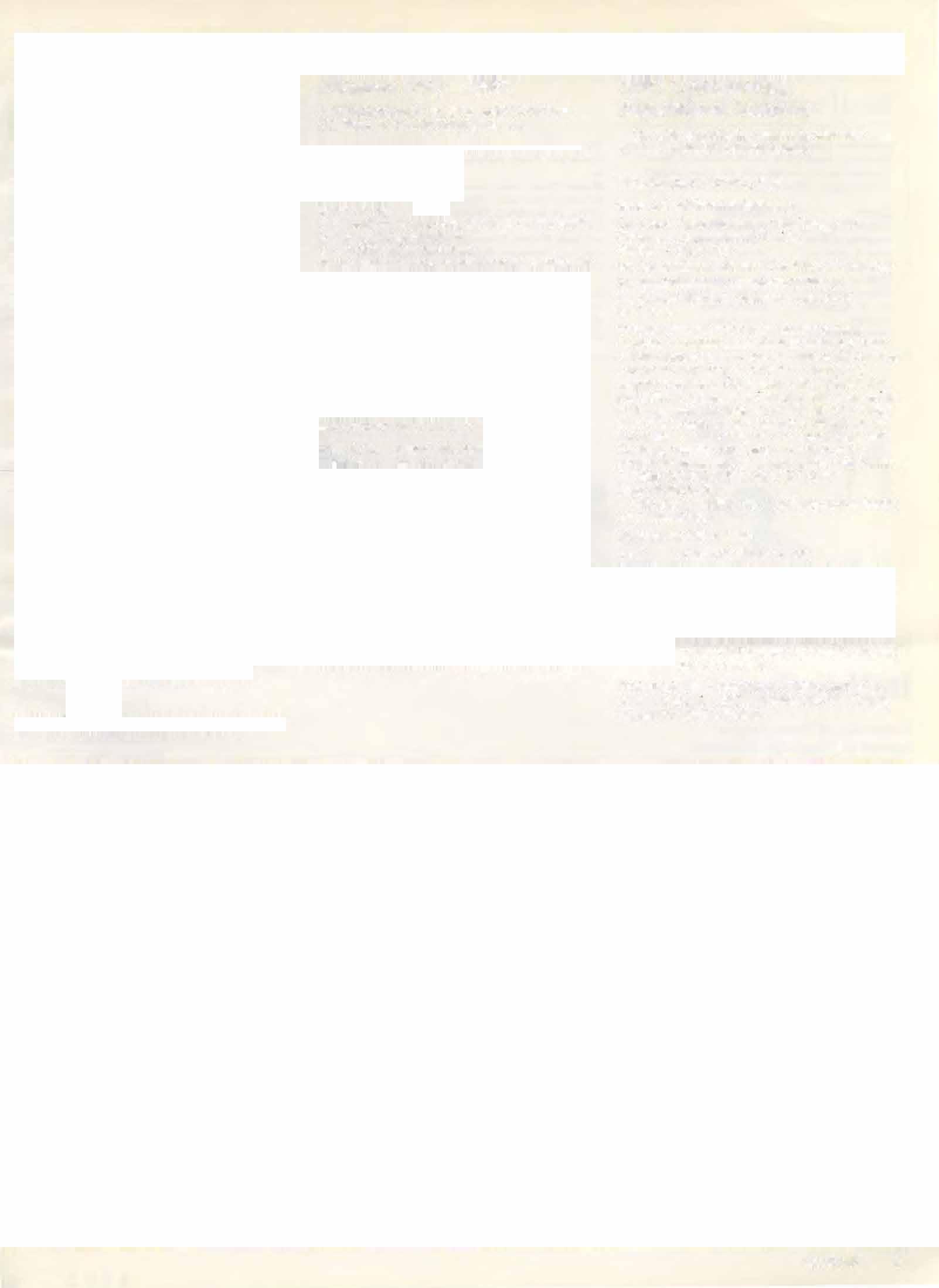
The Development Office reports that gifts. subscnption�. �nd beque'itS to the Second Century Fund campaign totaJ $27,370.008 as of February 6. 1987.
In tbe last three month). the School ha!. rece1ved a grant ofS100.000 Irom the Marilyn M. Simpson Charitable Trus� for the Center for the interaction of Ammal:. and Soctety� a three-year. $158.000 grant from the Jessie B. Cox Charitable Trust to support a semor faculty position in molecular genetics; and $160.000 over two years from the Robert J. Kleberg, Jr., and Helen C Kleberg Foundation to support studies on the control ofgene expression tn the bovine leukem1a virus (BLV) and the development of a BLV vaccme.
Todate, gifts :llld subscrpuons for the con!ltruction of the Comparative Orthopedic Biomechanics Laboratory at New Bolton Center total $100,000 toward an estimated construction cost of$400.000.
Another S200.000 must be in hand b) June 30, 1987. to complete all final phases of the Connelly Intensive Care''leo-Natal Unit now being built at New Bolton Center. Contributions for this major addjtion to the Widener Hospital complex arejust shy of $2 million
AlumniDay-1987
SATURDAY, MAY 16. 1987 �EW BOLTO CENTER, KENNETI SQUARE, PA
N o driving necessary-transportation to all tours available
E '<Citement
W interthur Tour
B eer on Tap
0 bviously-you can't help but have a great time!
L ongwood Gardens Tours
T our of New Bohon Center
0 pportunities to !lee the improvements made at the large arumal campus
N ICC surroundings
C omradery
E eat-Buffet Luncheon
N ature at its best
T alk with your classmates. Dean Marshal>., and Faculty Members
E ntertaiornent
R ela..lC and have a great day
SATURDAY, MAY 16, 1987
11:00 A.M. Annual Meeting
12:00 Noon Buffet Luncheon
2:00 P.M. Tours of �ew Bolton Center. Winterthur Museum, or Longwood Gardens (transportation provided)
6:30 P.M. Veterinary Alumni Reception and Dinner Dance at the Radisson Hotel, Wilmington, Delaware
lf you haven't recetved your invitation yet, please call the Veterinary Alumni Office at (215) 898-4234.
COME ONE-COME ALL TO OUR ALUMNI DAY FESTIVITIES WHETHER YOU'RE CELERRATING YOUR 5th OR YOUR 50th REUNIO�. OR JUST COME OUT FOR THE FUN Of IT!!
1987Continuing EducationCourses
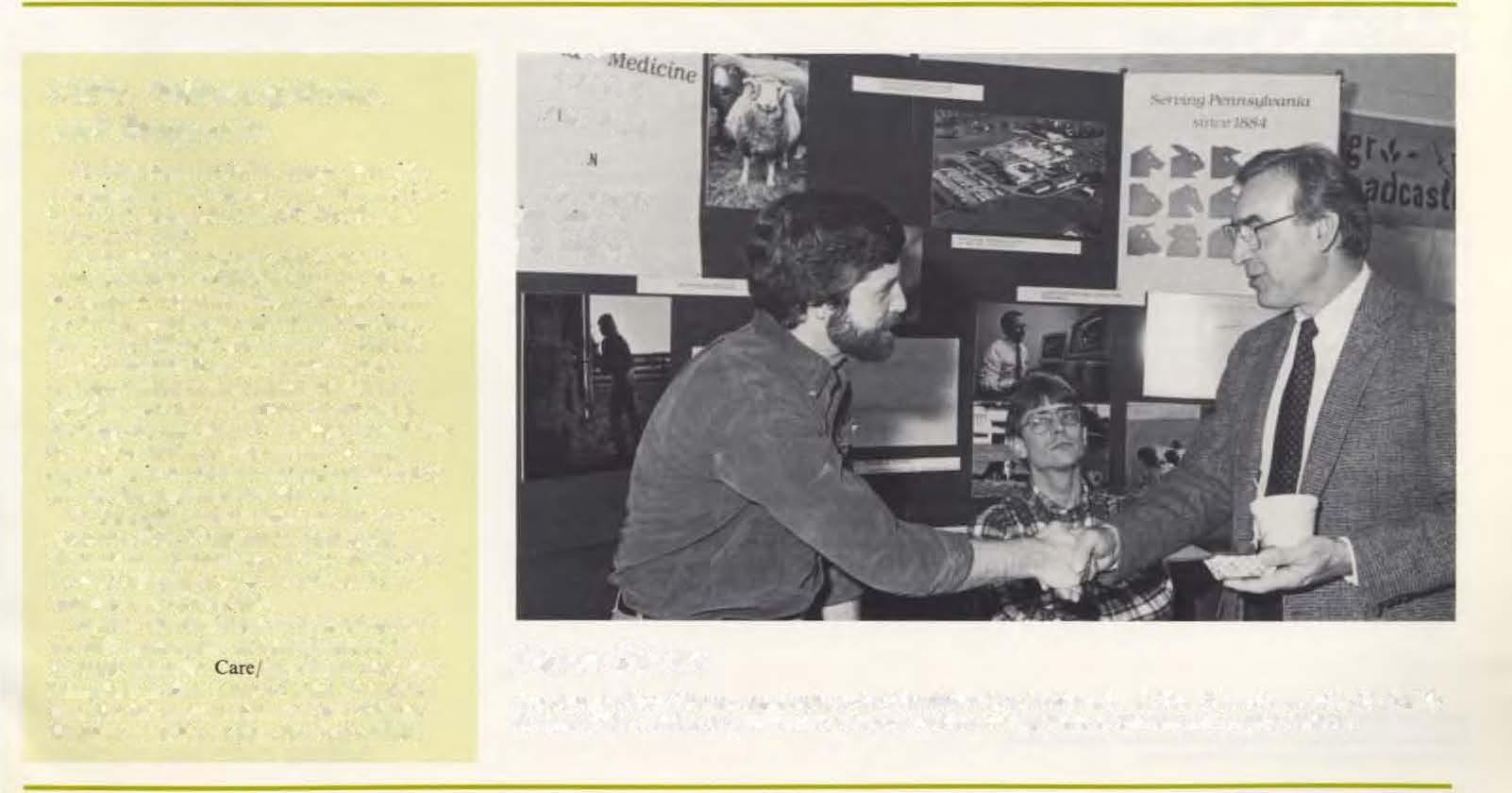
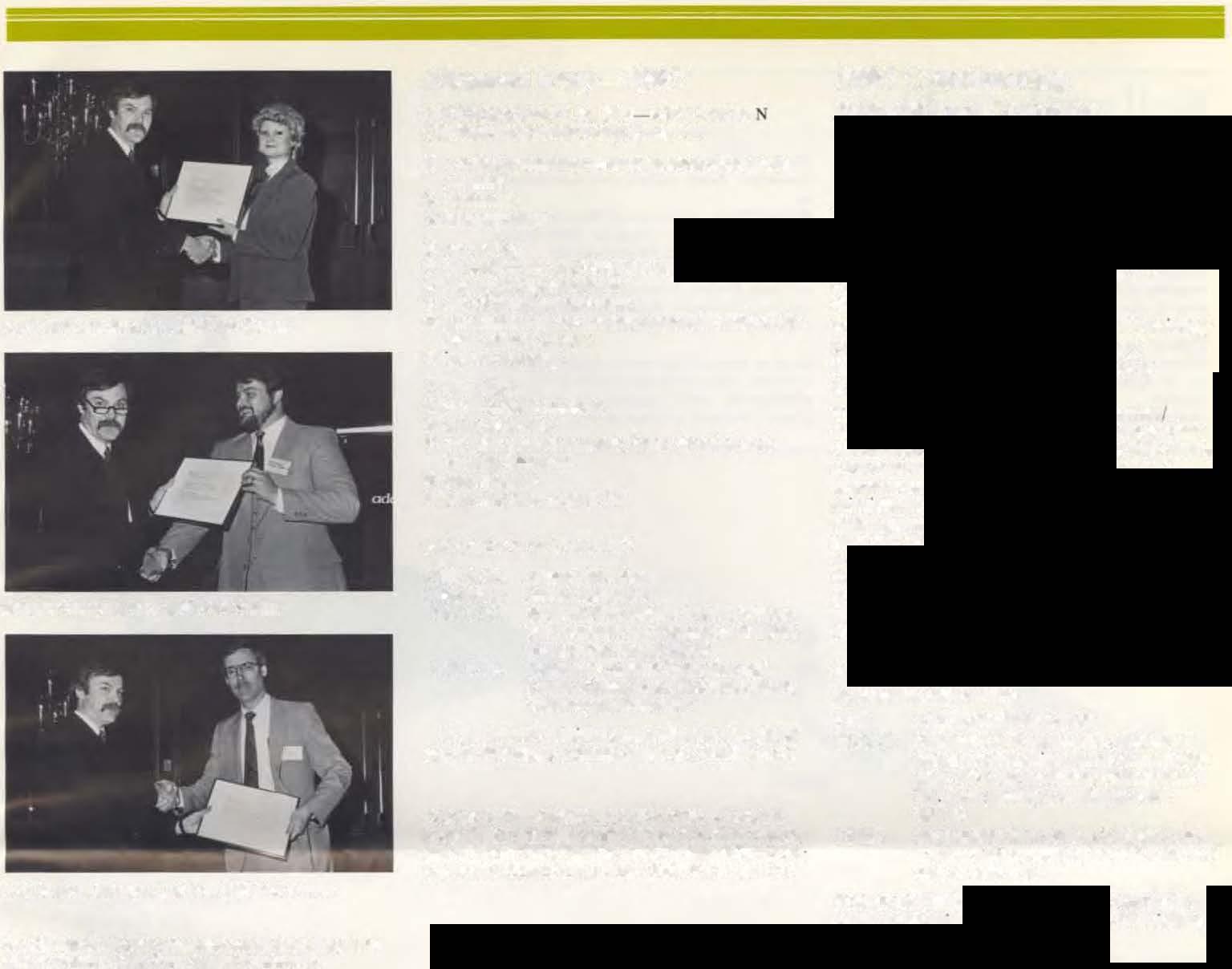
The following full-day continuing education seminar is scheduled for the Spring:
WEDNESDAY, JUNE 3. 1987
Small Animal Skeletal Radiology
Dr. Darryl Biery, Professor of Radiology and Chairman, Department of Clintcal Studies-Philadelphia
Dr. Sydney Evans, Assistant Professor of Radtology
Dr. Mark Saunders. Lecturer in Radiology
Dr. Jeffrey Wortman, Assistant Professor of Radiology
This program will be a comprehensive lecture workshop on small animal skeletal radiology. There will be approximately a one-hour lecture followed by a two-hour workshop in both the morning and afternoon sessions. The lectures y,iJI emphasize the pnnctples of radiographic Interpretation ofthe spme. skull. appendicular skeleton. and joints. The workshop will be handled as a laboratory with teamb of two to three people assigned to a viewbox with the Radiology faculty circulating to assist in radiographic interpretation of selected auto-tutorial cases. TH1S COURSE IS LIMITED TO 30 PARTICIPA..'ITS.
nus course qualifLes for eight hours of Continuing Education Credit.
Registration Information:
FEE: $125.00 (Includes Lunch)
PLACE: University of Pennsylvania. School of Veterinary Medicme, Small Animal Hospital, 3850 Spruce Street. Philadelphia, PA Free parking il. available at the School.
TIME: R�istratioo from 8:00 A.M.-9:00 A.M. Course begins promptly at9:00 A.M. and ends at 5:00 P.M.
FOR FURTHER INFORMATION CONTACT: A�hra Markowttz, Office of Veterinary Contmuing Education-(215) 898-1882.
Bellwether is published by the School of Veterinary Medicine at the University ofPennsylvania. in cooperation with the University of Pennsylvania, Office ofUniversity Relations.
Editor: Helma Weeks
AssistantEditor:
John E. Martin.
I":M.D.
Writers:
Helma Weeks
Dr. M. Josephine
Deubler (Animal Crackers)
lllustraJor Marie Garofano
Photographers:
Am/tony Wood
Lynne R. Klunder
New BoltonLiaison: Catherine Larmore
Distribution:
June Johns
Bellwether
University of Pennsylvania
School of Veterinary Medicine
3800 Spruce Street Philadelphia) PA 19104-6008
47475/4.87/11M LF.RC
Produced
Spring 1987
Wetl like to hearyourprase. tritidsms. or comments. Please address your correspondence to: Helma Weeks. UniversityofPemuylvania. Schoolof Veterinary Medicine. 3800 Spruce Street, Philadelphia. PA 19104-6010 (115)-898-1475
or Linda Fischer, UniversityofPennsylvania, Office of University Relauons. 410 Logon Hall. Philadelphia, PA 19104-6008
None ofthese articles are to he reprotluc:ed in anyform without the permis!iion ofthe edirors ofBellwether. 1987 Copyright h1•the Trustees ofrhe University ofPennsylvama.
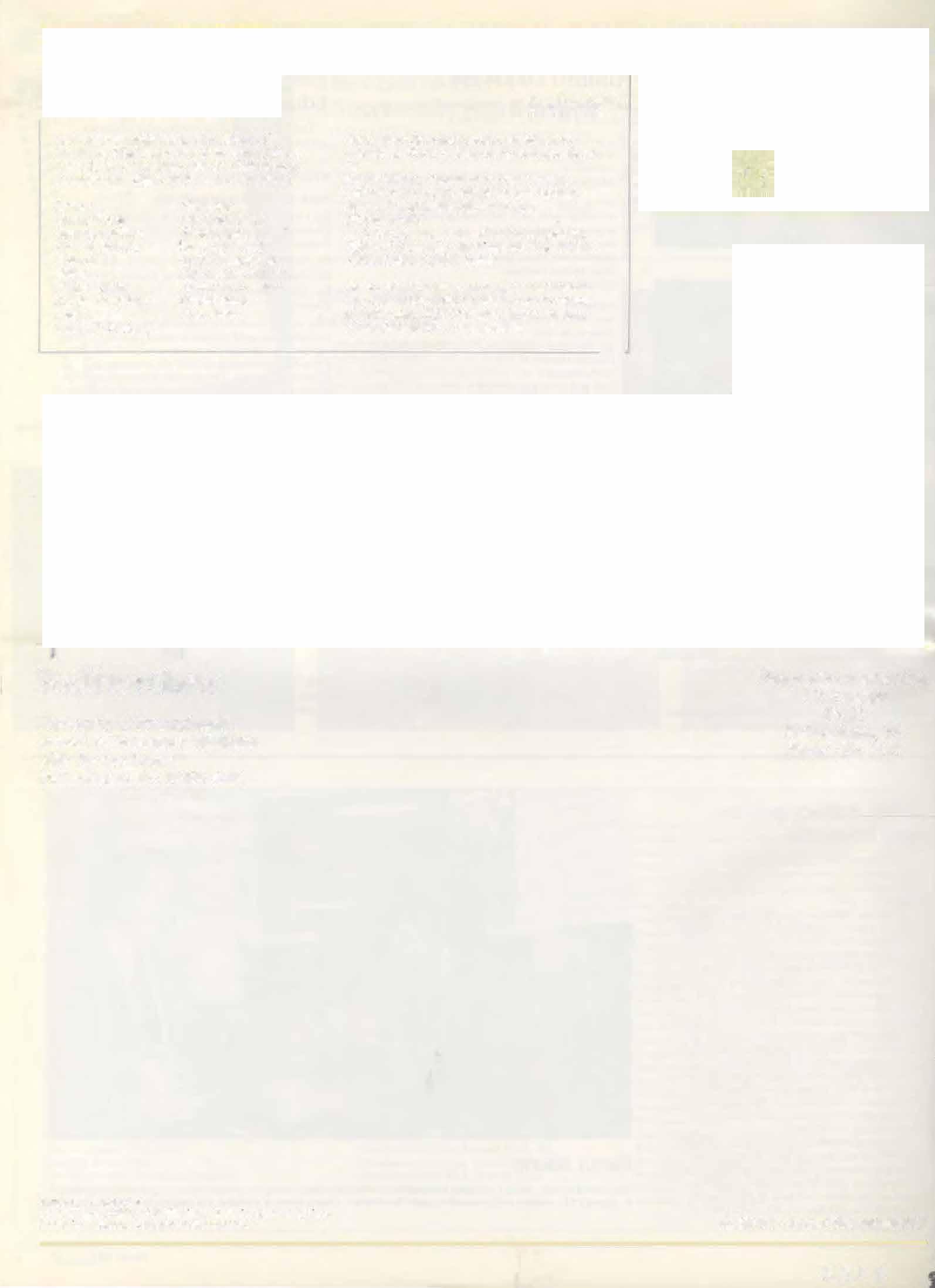
Calendar
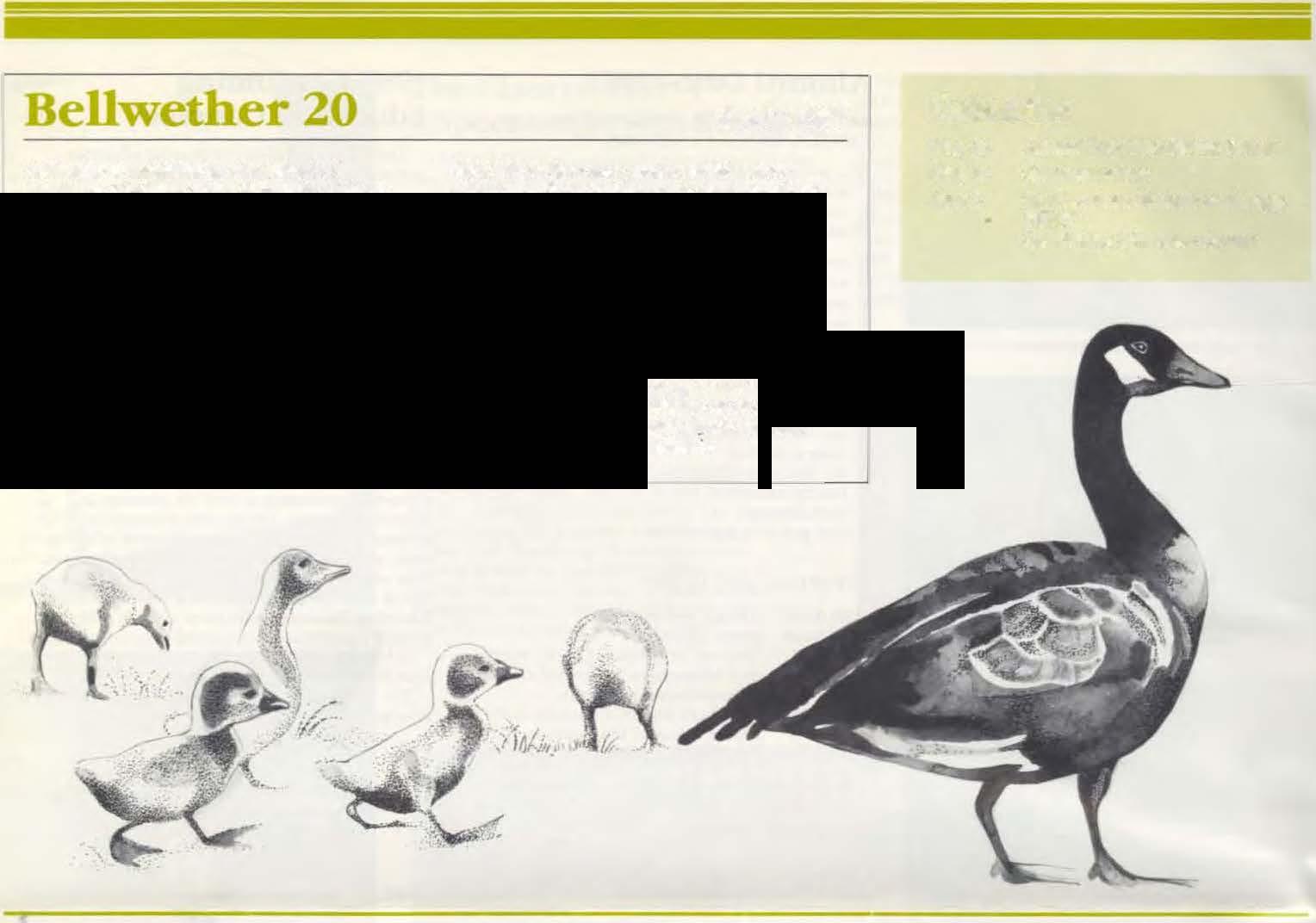
May 16
May 18
June 3
Alumni Day, New BoltonCenter Commencement
Small Animal Skt:letal Radiology. VHUP
Continuing Education Course
Nonprofit Organization US Postage PAID
Philadelphi� PA
Permit No 2147 Address correction requested
bythe Office ofPublicouons/ Markeung Communicauons, Univc�aty Relations, Uruversity of Pennsylvania